Temporary Pacing Simulator: A Training Tool for Clinicians
Abstract
1. Introduction
2. Materials and Methods
2.1. Data Collection
2.2. System Overview
2.3. Generation of Pacing Modes Using Algorithms
2.3.1. Ventricular Pacing
2.3.2. Atrial Pacing
2.3.3. Dual Pacing
2.4. Generation of Pacing Failures Using Algorithms
2.5. The Encapsulation of the Simulator on a User Interface
2.5.1. Welcome Window Initialization
2.5.2. Main Simulation Panel Window Initialization
- Window Definition: At each update, a new segment (or window) of the signal is defined. This window consists of a fixed number of data points, representing a short duration of the signal.
- Index Increment: The starting point of the window is incremented by a predefined number of data points, shifting the window forward along the signal. This incremental shift creates the appearance of a moving signal.
- Plot Clearing and Redrawing: Before plotting the new window, the current plot is cleared to remove the old data. The new segment of the signal is then plotted within the cleared axes.
- Canvas Redrawing: The canvas, which is the plotting area within the Tkinter interface, is redrawn to display the updated plot.
- Periodic Function Call: The program uses a periodic function call mechanism to ensure that the plot updates at regular intervals. This is typically set to one second, aligning with the real-time aspect of the simulation.
- Title and Styling: The title “Temporary Cardiac Pacing Settings” is displayed at the top of the right frame in bold and centered for emphasis.
- Baseline Rhythm Selection: The user selects the baseline rhythm from a dropdown menu. This input is essential as it influences the available pacing modes and signal baselines. The options include various rhythm types such as ‘A-tach 2:1 block’ (TAH), ‘AF’, ‘SR’, ‘SR with LBBB’, and ‘SR with VEs’.
- Pacing Mode Selection: Depending on the selected baseline rhythm, the user can choose a pacing mode from the dropdown menu, which includes options like ‘VVI’, ‘VOO’, ‘AAI’, ‘AOO’, ‘DDI’, and ‘DOO’. This selection determines the type of pacing to be simulated.
- Pacing Rate Input: A text entry field allows the user to input the desired pacing rate in bpm.
- Pacing Rate Validation: An adjacent button validates the entered rate, ensuring it falls within the acceptable range (bpm).
- Optimal AV Delay Input: Users can input an optimal AV delay value. There are buttons to plot AV delay data and validate the entered AV delay, providing feedback on whether the value is correct based on preloaded data.
- AV Time Delay Selection: A dropdown menu is available for selecting the AV time delay, with options ranging from 40 to 300 milliseconds. This field is enabled only for specific pacing modes that require an AV delay input.
- Failure Mode Selection: Users can select a failure mode from a dropdown menu, which includes options like ALOC, VLOC, undersensing, and oversensing. This selection is used to simulate different pacing failures and the failures are enabled or disabled depending on the selected pacing mode.
- Threshold Inputs: Four additional sections are provided for inputting atrial and ventricular capture and sensitivity thresholds. Each section includes a label, a text entry field, and a button to validate and apply the input. These thresholds help in simulating specific conditions related to the sensitivity and capture capabilities of the TP. similarly to the failure modes, the threshold buttons are enabled or disabled depending on the selected pacing mode.
2.5.3. Baseline Rhythm Dropdown
- Resetting to Default State: Upon selection, the simulation resets all global variables and user interface components to their default states. The reset includes clearing signal data arrays, resetting indices, and disabling irrelevant input fields that were introduced in earlier phases of the simulation process. This ensures that any previous settings or selections do not interfere with the new baseline rhythm configuration.
- Signal Selection: The program extracts the corresponding signal data for the selected baseline rhythm. This involves retrieving the baseline ECG, ABP, and CVP signals from our dataset. The signal extraction is based on the user-selected rhythm, ensuring that the displayed signals accurately reflect the chosen cardiac condition.
- Updating Pacing Mode Options: Depending on the selected baseline rhythm, the available pacing modes are updated. For instance, if the rhythm is AF, only ventricular pacing modes (such as VVI or VOO) may be relevant and therefore enabled. The dropdown for pacing modes is dynamically populated with the appropriate options, ensuring that the user can only select compatible pacing modes.
- AV Time Delay Options Update: If the selected baseline rhythm requires AV delay optimization, the program updates the AV delay options accordingly. It searches for available AV delay signals for the selected patient or similar patients with the same baseline rhythm. If no AV delay signals are found for the selected patient, the program may look for another patient with the same baseline rhythm to provide relevant AV delay options.
- Plot Initialization and Update: The program initializes the plot area with the extracted baseline signals. The ECG, ABP, and CVP signals are displayed in their respective subplots. The plot is configured to update dynamically, simulating real-time signal monitoring.
- User Feedback and Interaction: Throughout this process, the user receives immediate visual feedback as the plot updates to reflect the selected baseline rhythm. Any invalid selections or inputs trigger warning messages, guiding the user to make appropriate choices. This interactive feedback mechanism ensures a smooth and intuitive user experience, facilitating effective learning and analysis.
2.5.4. Pacing Mode Dropdown
- Validation of Baseline Rhythm: The program first checks whether a baseline rhythm has been selected. If no baseline rhythm is chosen, the user is prompted to select one before proceeding with pacing mode selection. This ensures that pacing parameters are applied within the context of a defined cardiac condition.
- Updating Pacing Mode Options: Based on the selected baseline rhythm, the pacing mode dropdown is populated with relevant options. For example, certain pacing modes may be disabled if they are incompatible with the chosen baseline rhythm.
- Enabling/Disabling Input Fields: The selection of a pacing mode dynamically enables or disables various input fields and dropdowns related to pacing parameters. For instance, dual-chamber pacing modes (such as DDI or DOO) enable the AV delay dropdown, as these modes require synchronization between atrial and ventricular pacing. Input fields for pacing rate, capture thresholds, and sensitivity thresholds are also enabled or disabled based on the selected pacing mode. This ensures that users can only interact with relevant controls, minimizing the risk of invalid configurations.
- Interaction with AV delay dropdown: For dual-chamber pacing modes, the AV delay dropdown is set to ‘readonly’ to allow users to select an appropriate delay. This dropdown remains disabled for single-chamber pacing modes where AV delay is not applicable.
- Updating Failure Mode Options: The available failure modes are updated based on the selected pacing mode. Failure modes such as undersensing, oversensing, atrial loss of capture, and ventricular loss of capture are dynamically populated in the failure mode dropdown. This allows users to simulate and analyze specific pacing failures relevant to the chosen mode.
- Real-Time Feedback and Visualization: Upon selecting a pacing mode, the program retrieves the corresponding paced signals for ECG, ABP, and CVP from the predefined datasets. These signals are then plotted within the graphical interface, providing immediate visual feedback to the user.The plot area is updated dynamically, simulating real-time signal monitoring. This visualization helps users understand the impact of the selected pacing mode on cardiac function.
- Plot Update and Redrawing: The selected pacing mode influences the window of data displayed on the plot. The program ensures that the appropriate signals are plotted, clearing the previous data and updating the plot with the new signals. This process provides a clear and accurate representation of the pacing effects.
- User Guidance and Warnings: Throughout the process, the user receives real-time guidance and warnings. For instance, if an invalid pacing mode is selected, or if a required parameter is not set, the program displays warning messages, prompting the user to correct the input. This interactive feedback mechanism ensures a smooth and intuitive user experience, facilitating effective learning and analysis.
2.5.5. Pacing Flows and TP Thresholds Settings
2.5.6. Capture Thresholds
2.5.7. Sensitivity Thresholds
2.5.8. Managing AV Delay in Dual-Chamber Pacing Modes
3. Experimental Results
3.1. Pacing Modes Scenarios
3.2. Pacing Failure Scenarios
3.3. Capture and Sensitivity Thresholds
3.4. AV Delay in Dual-Chamber Pacing Modes
4. Discussion
5. Conclusions
Supplementary Materials
Author Contributions
Funding
Institutional Review Board Statement
Informed Consent Statement
Data Availability Statement
Acknowledgments
Conflicts of Interest
Abbreviations
| AAI | Atrial pacing and sensing |
| ABP | Arterial line blood pressure |
| AF | Atrial fibrillation |
| ALOC | Atrial loss of capture |
| AOO | Atrial asynchronous pacing |
| AV | Atrioventricular |
| AV delay | Atrioventricular delay |
| CVP | Central venous pressure |
| CVDs | Cardiovascular diseases |
| DAQ | Data acquisition |
| DDI | Dual pacing and sensing with inhibited response in one chamber |
| DOO | Dual asynchronous pacing |
| ECG | Electrocardiogram |
| GUI | Graphical User Interface |
| HRA | Health Research Authority |
| ICU | Intensive care unit |
| IRAS | Integrated Research Application System |
| LBBB | Left bundle branch block |
| NHS | National Health Service |
| PPM | Permanent pacemaker |
| RR interval | Interval between R peaks on an ECG |
| SR | Sinus rhythm |
| TAH | Tachycardia |
| TCPS | Temporary Cardiac Pacing Simulator |
| TP | Temporary pacing |
| VEs | Ventricular ectopics |
| VLOC | Ventricular loss of capture |
| VOO | Ventricular asynchronous pacing |
| VVI | Ventricular pacing and sensing |
Appendix A
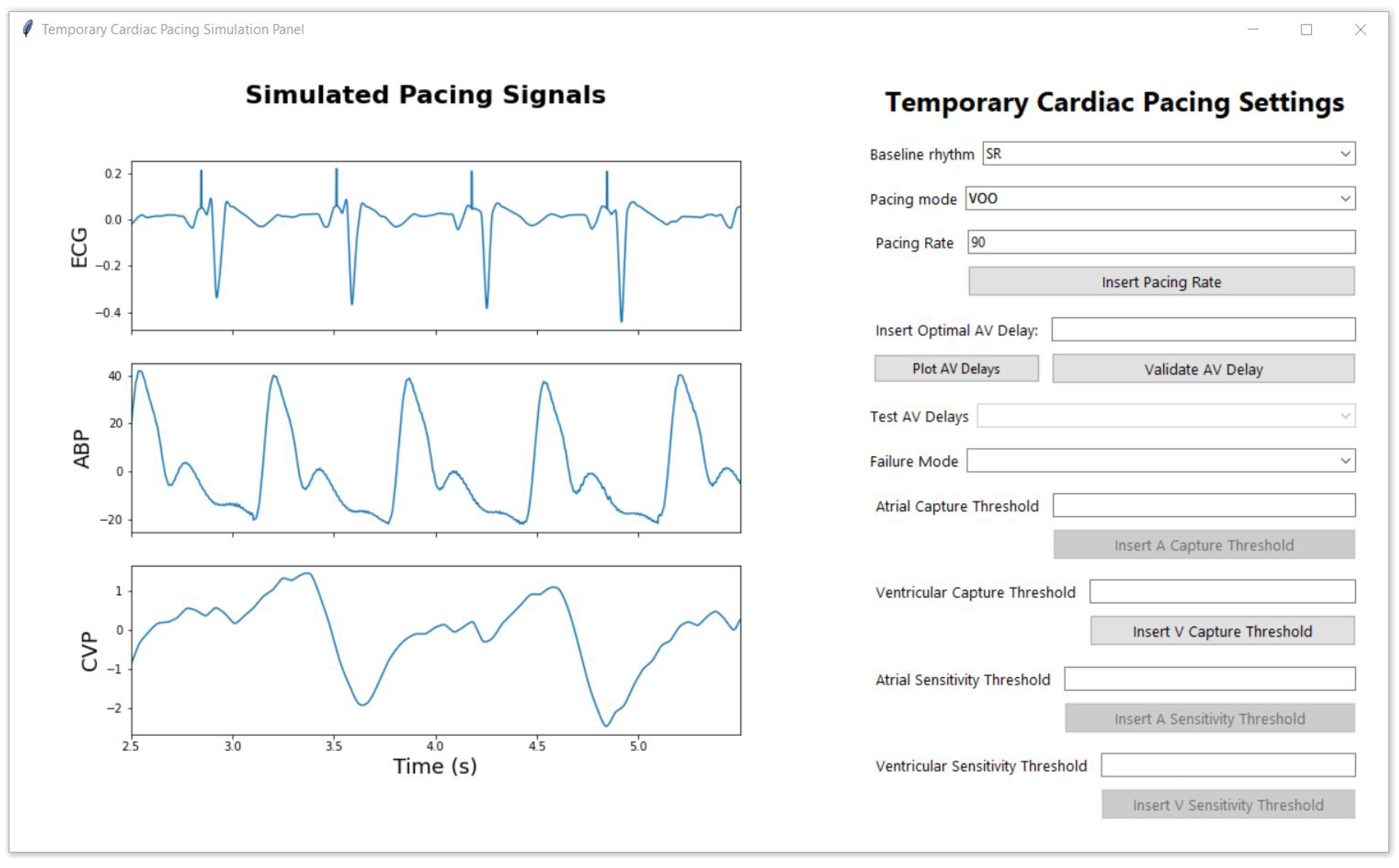

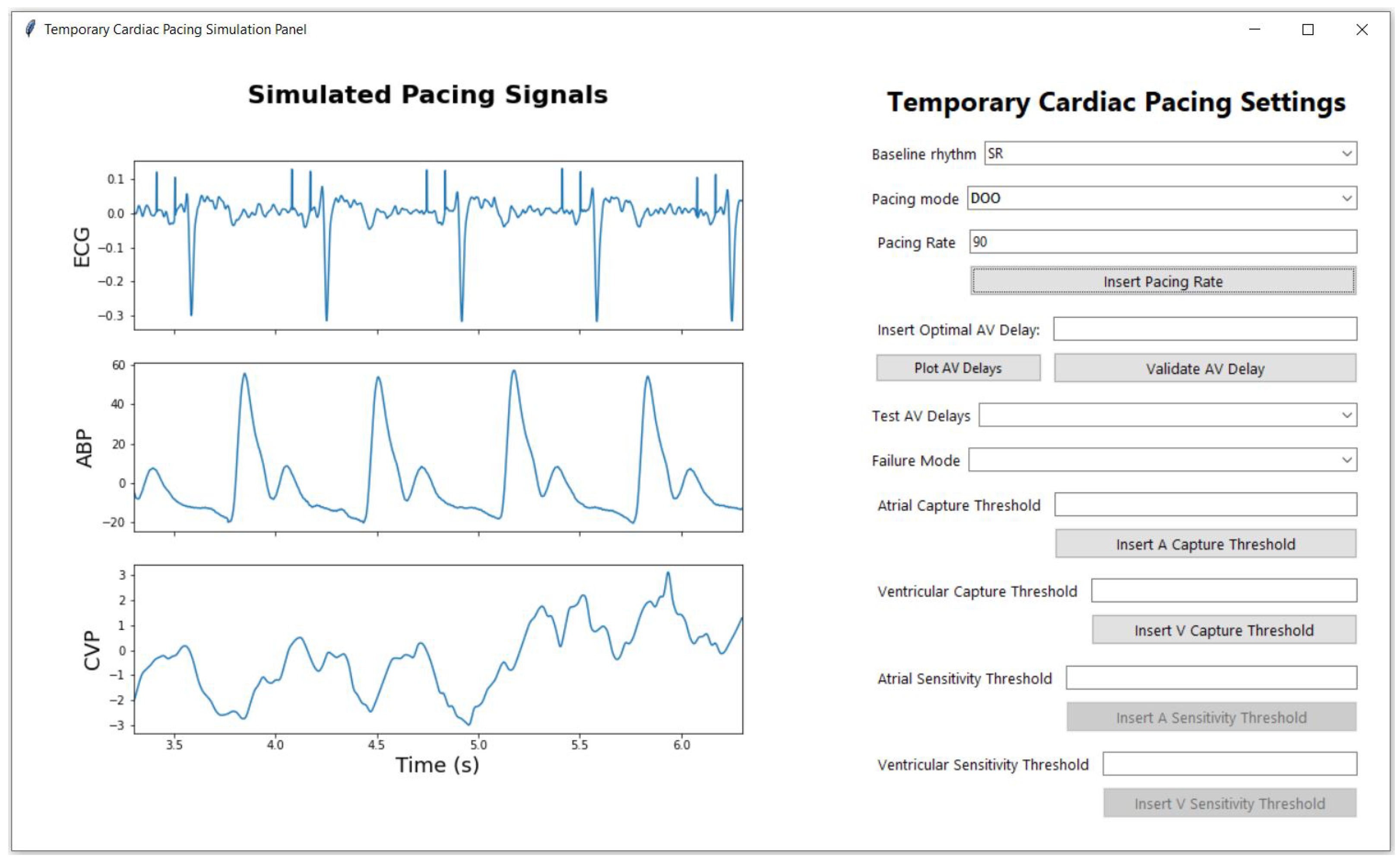

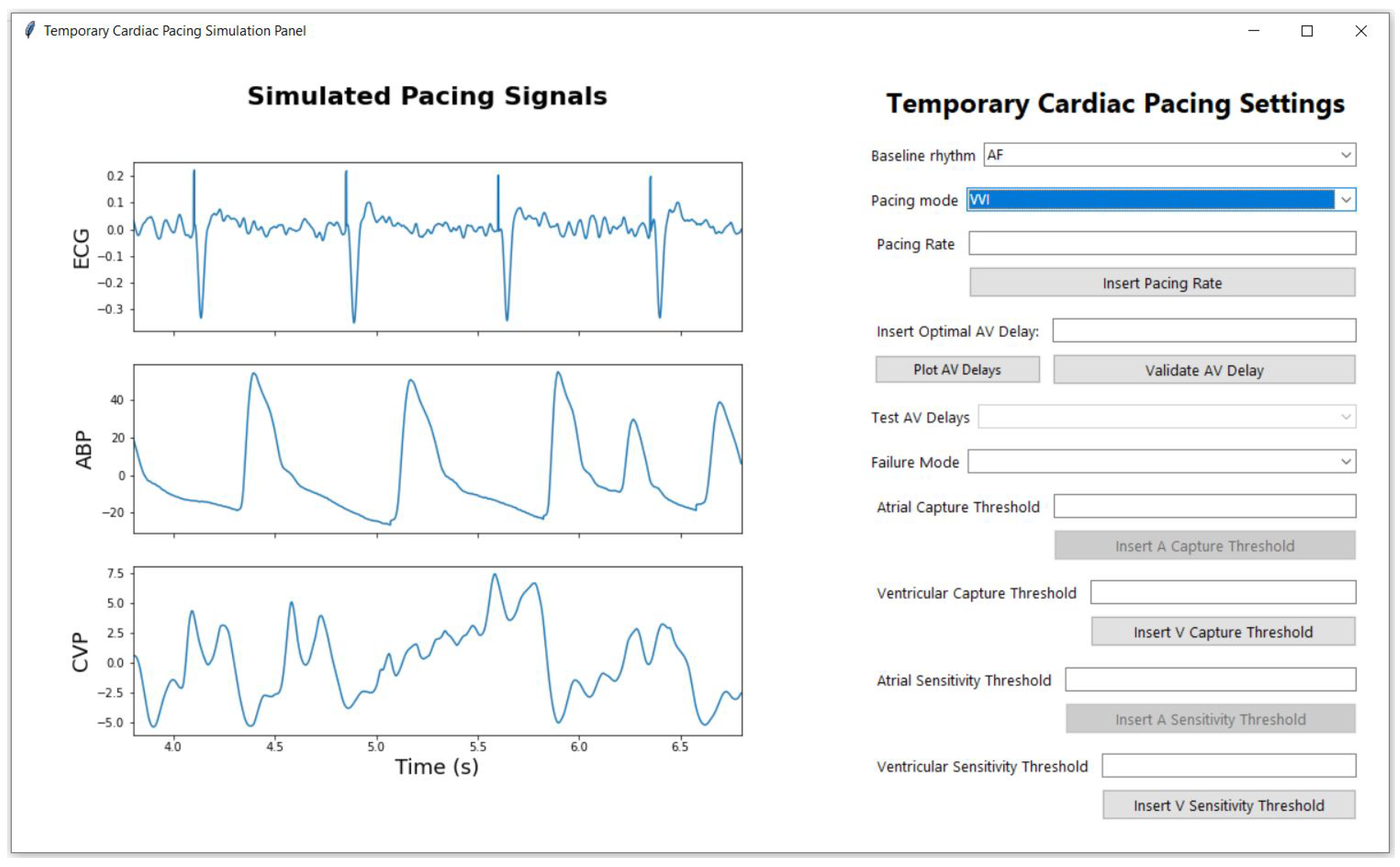

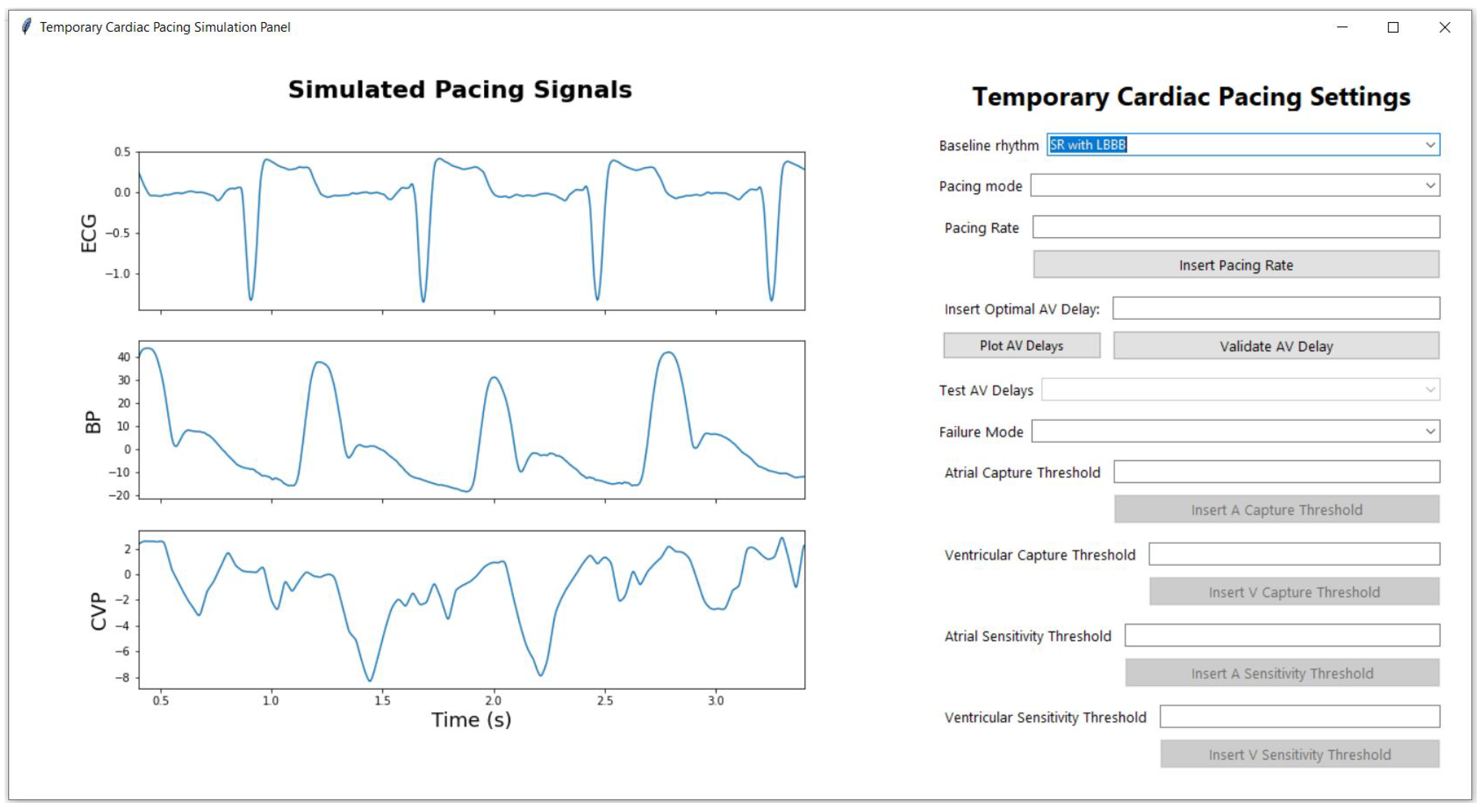


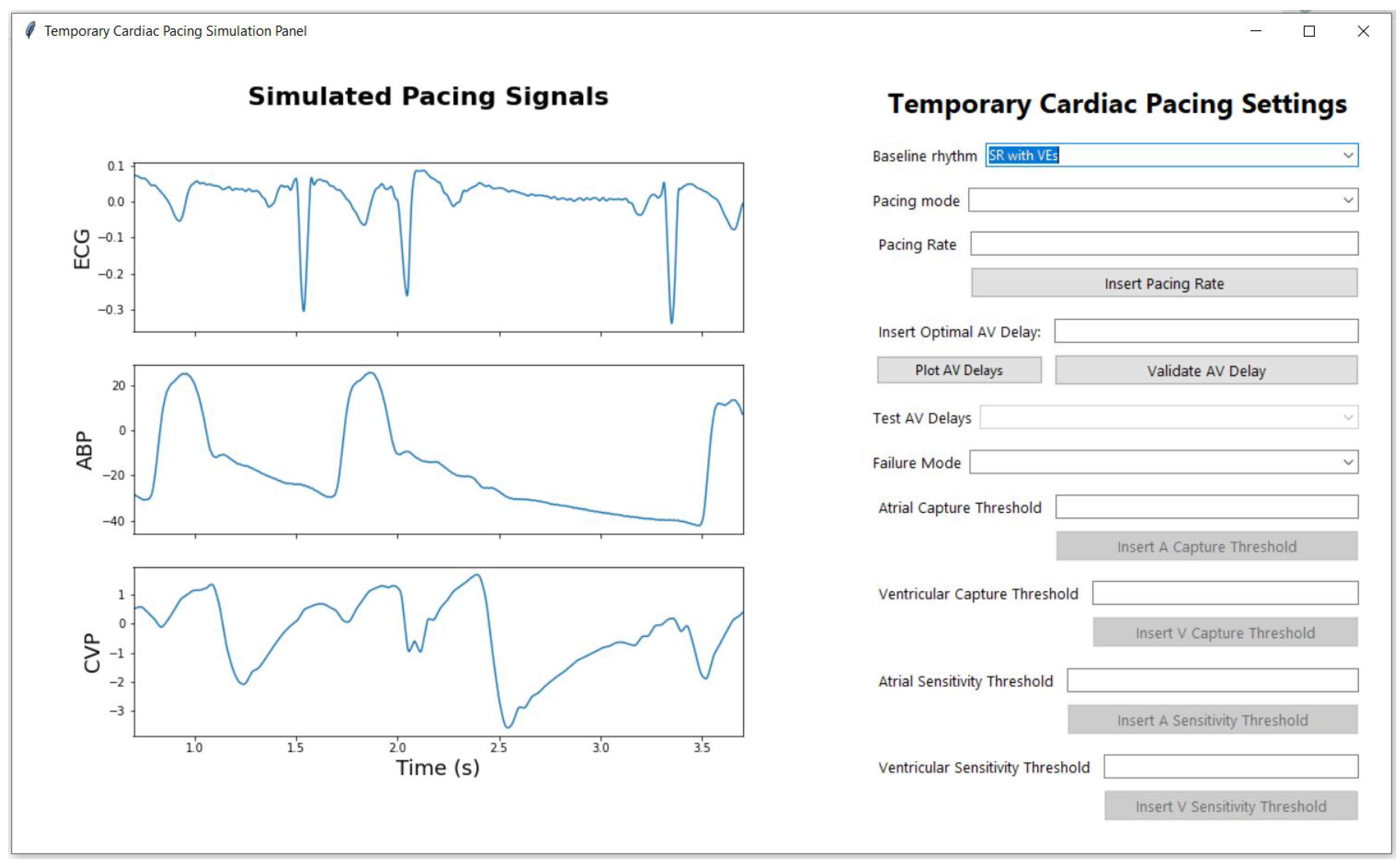
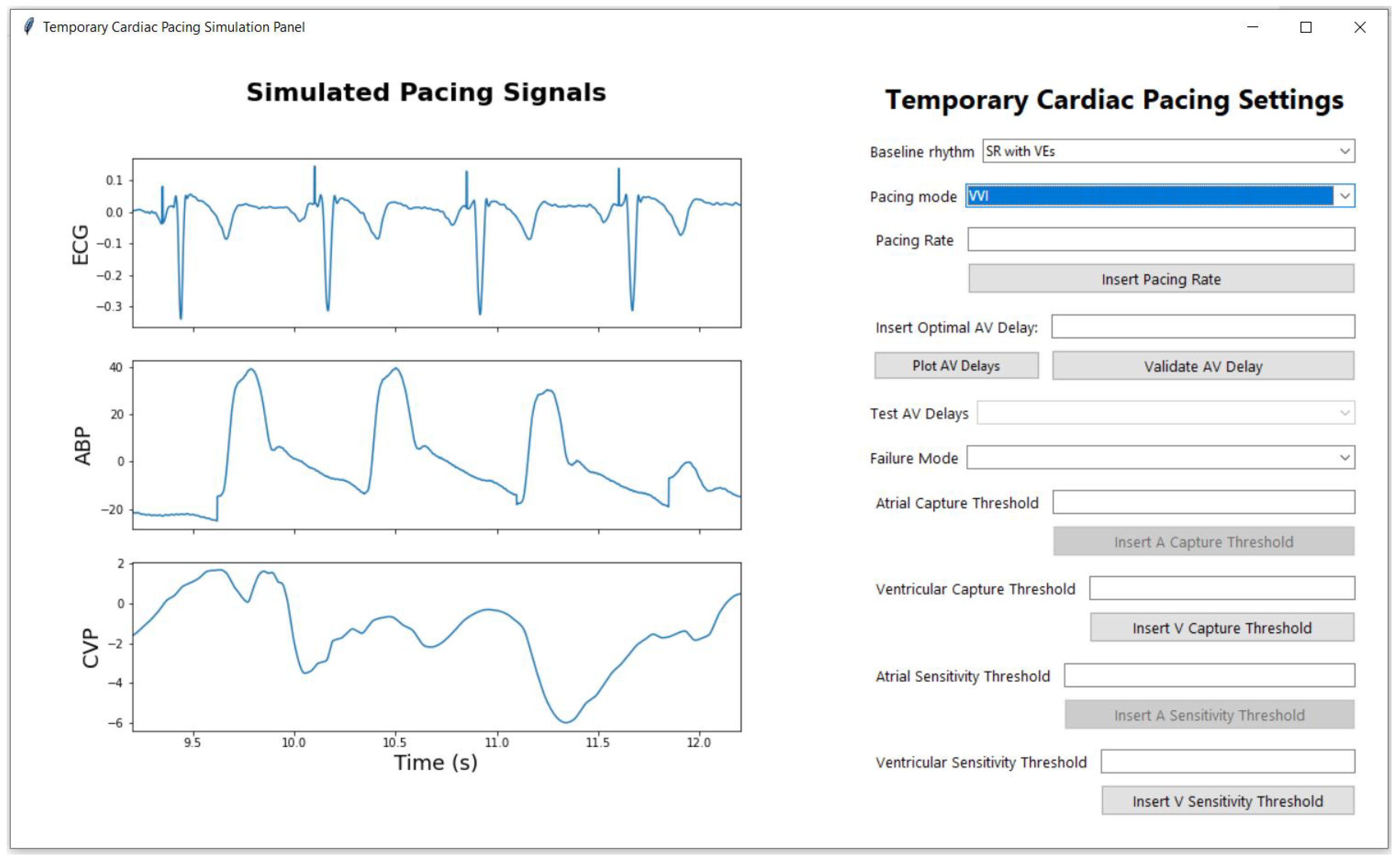
References
- Laslett, L.J.; Alagona, P.; Clark, B.A.; Drozda, J.P.; Saldivar, F.; Wilson, S.R.; Poe, C.; Hart, M. The worldwide environment of cardiovascular disease: Prevalence, diagnosis, therapy, and policy issues: A report from the American College of Cardiology. J. Am. Coll. Cardiol. 2012, 60, S1–S49. [Google Scholar] [CrossRef] [PubMed]
- Ulster University. CVD Statistics: Cardiovascular Disease Is the Current Leading Cause of Death Worldwide. 2019. Available online: https://www.ulster.ac.uk/cardiovascular/cvd-prevalence (accessed on 18 July 2024).
- Cronin, B.; Dalia, A.; Goh, R.; Essandoh, M.; Orestes O’Brien, E. Temporary Epicardial Pacing After Cardiac Surgery. J. Cardiothorac. Vasc. Anesth. 2022, 36, 4427–4439. [Google Scholar] [CrossRef] [PubMed]
- Ayerbe, J.L.; Sabaté, R.V.; García, C.G.; Leor, O.R.; Pérez, M.G.; Abadal, A.C.; Flores, J.S.; Larrousse, E.; Valle, V. Temporary pacemakers: Current use and complications. Rev. Esp. Cardiol. 2004, 57, 1045–1052. [Google Scholar]
- Calvanese, R.; Conti, M.A.; Kol, A.; Pignalberi, C.; a cura dell’Area Aritmie ANMCO. Temporary cardiac pacing: 50 years old and still young. G. Ital. Cardiol. 2023, 24, 810–817. [Google Scholar]
- Diemberger, I.; Massaro, G.; Rossillo, A.; Chieffo, E.; Dugo, D.; Guarracini, F.; Pellegrino, P.L.; Perna, F.; Landolina, M.; De Ponti, R.; et al. Temporary transvenous cardiac pacing: A survey on current practice. J. Cardiovasc. Med. 2020, 21, 420–427. [Google Scholar] [CrossRef] [PubMed]
- Overbay, D.; Criddle, L.M. Mastering temporary invasive cardiac pacing. Crit. Care Nurse 2004, 24, 25–32. [Google Scholar] [CrossRef] [PubMed]
- Ng, A.C.C.; Lau, J.K.; Chow, V.; Adikari, D.; Brieger, D.; Kritharides, L. Outcomes of 4838 patients requiring temporary transvenous cardiac pacing: A statewide cohort study. Int. J. Cardiol. 2018, 271, 98–104. [Google Scholar] [CrossRef] [PubMed]
- Murphy, J. Problems with temporary cardiac pacing: Expecting trainees in medicine to perform transvenous pacing is no longer acceptable. BMJ 2001, 323, 527. [Google Scholar] [CrossRef] [PubMed]
- Timperley, J.; Leeson, P.; Mitchell, A.R.J.; Betts, T. (Eds.) Temporary cardiac pacing. In Pacemakers and ICDs, 2nd ed.; Oxford Specialist Handbooks in Cardiology; Oxford University Press: Oxford, UK, 2018. [Google Scholar]
- Sullivan, B.L.; Bartels, K.; Hamilton, N. Insertion and management of temporary pacemakers. Semin. Cardiothorac. Vasc. Anesth. 2016, 20, 52–62. [Google Scholar] [CrossRef] [PubMed]
- Crowe, M.E.; Hayes, C.T.; Hassan, Z.U. Using software-based simulation for resident physician training in the management of temporary pacemakers. Simul. Healthc. 2013, 8, 109–113. [Google Scholar] [CrossRef] [PubMed]
- Makowski, D.; Pham, T.; Lau, Z.J.; Brammer, J.C.; Lespinasse, F.; Pham, H.; Schölzel, C.; Chen, S.H.A. NeuroKit2: A Python toolbox for neurophysiological signal processing. Behav. Res. Methods 2021, 53, 1689–1696. [Google Scholar] [CrossRef] [PubMed]
- Hunter, J.D. Matplotlib: A 2D graphics environment. Comput. Sci. Eng. 2007, 9, 90–95. [Google Scholar] [CrossRef]
- Cretu, I.; Tindale, A.; Abbod, M.; Balachandran, W.; Khir, A.W.; Meng, H. A comparison of different methods to maximise signal extraction when using central venous pressure to optimise atrioventricular delay after cardiac surgery. IJC Heart Vasc. 2024, 51, 101382. [Google Scholar] [CrossRef]
- Cretu, I.; Tindale, A.; Balachandran, W.; Abbod, M.; Khir, A.W.; Meng, H. Synthesis of Multimodal Cardiological Signals using a Conditional Wasserstein Generative Adversarial Network. IEEE Access 2024, 12, 133994–134007. [Google Scholar] [CrossRef]
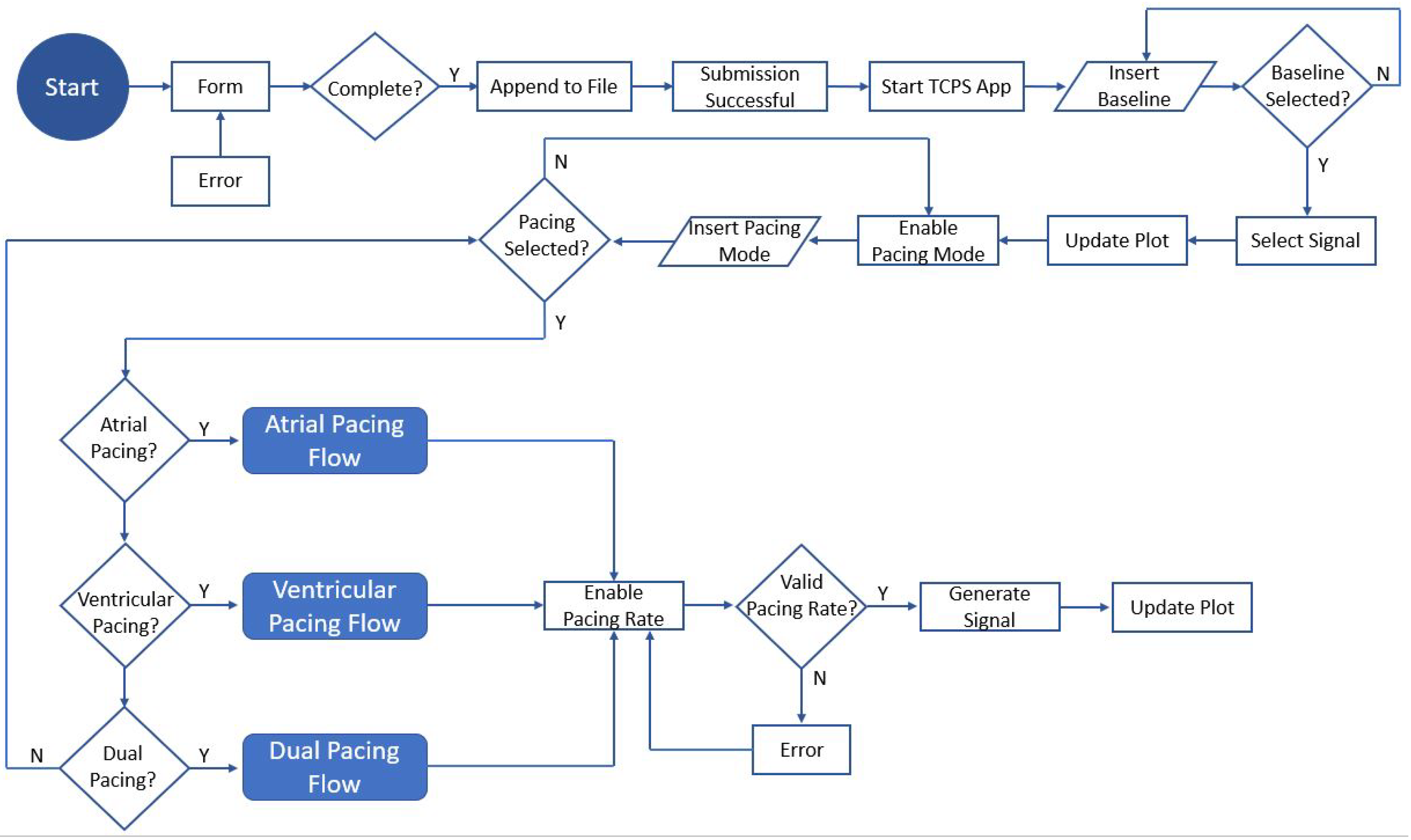
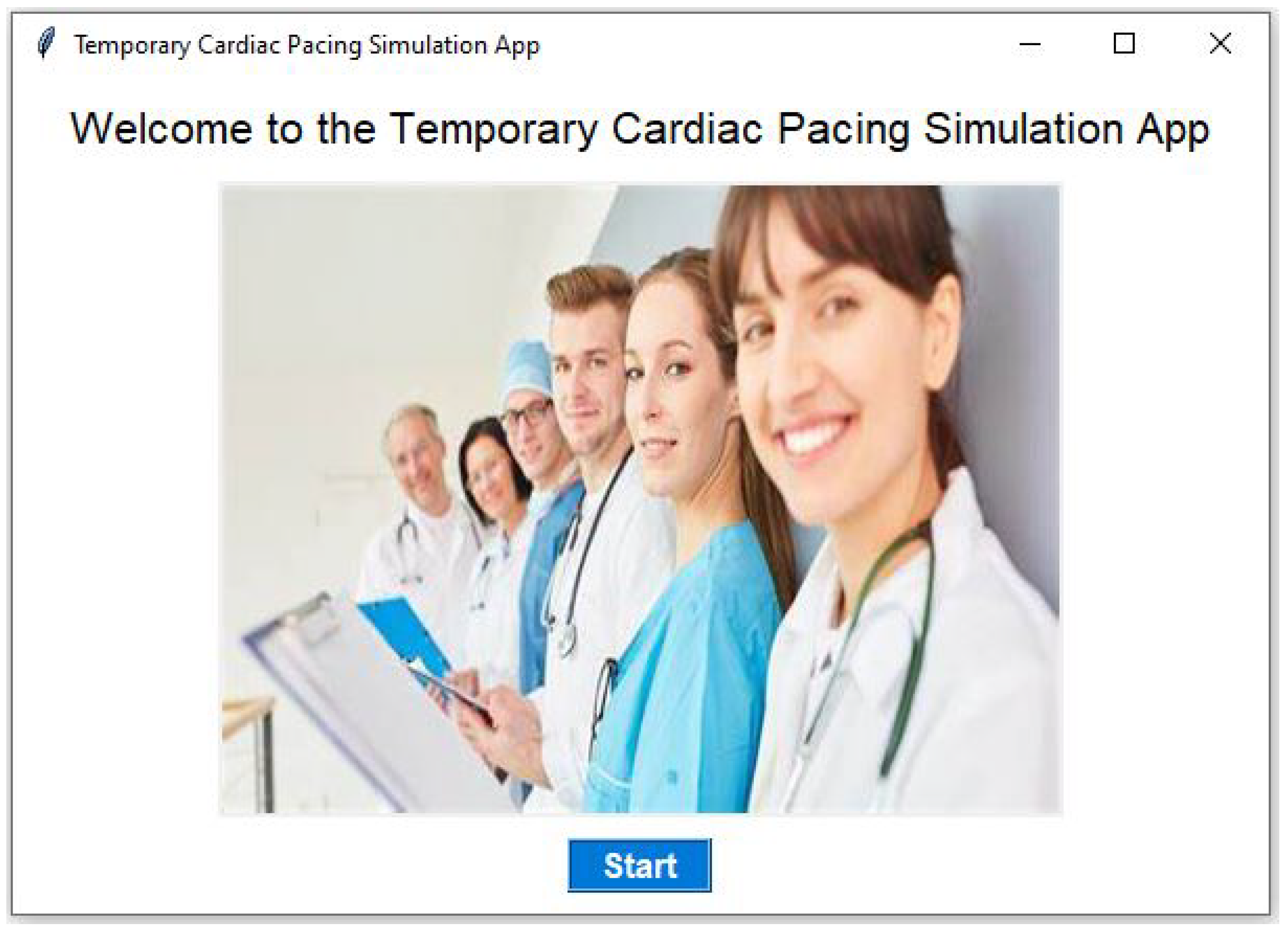

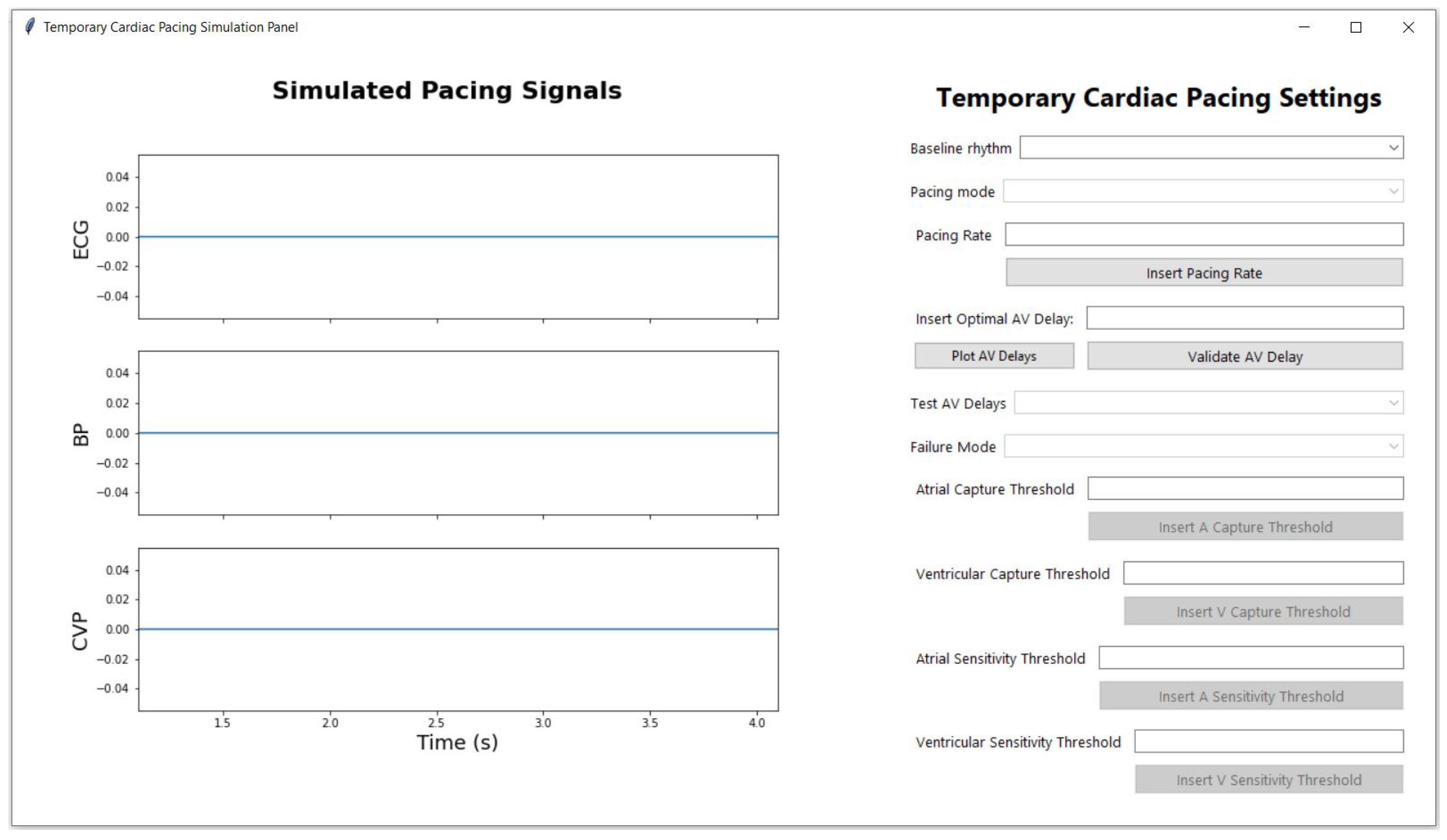
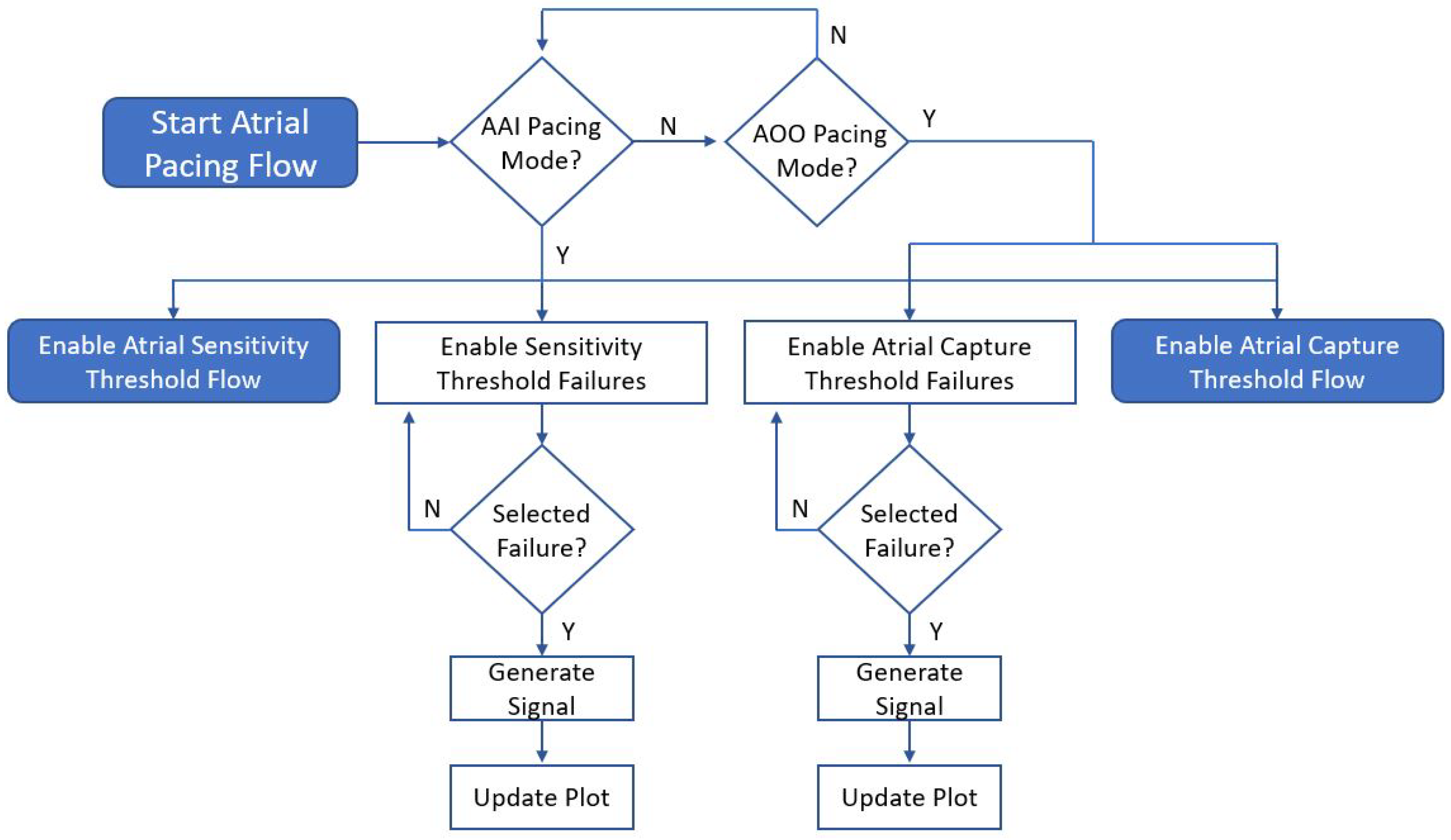

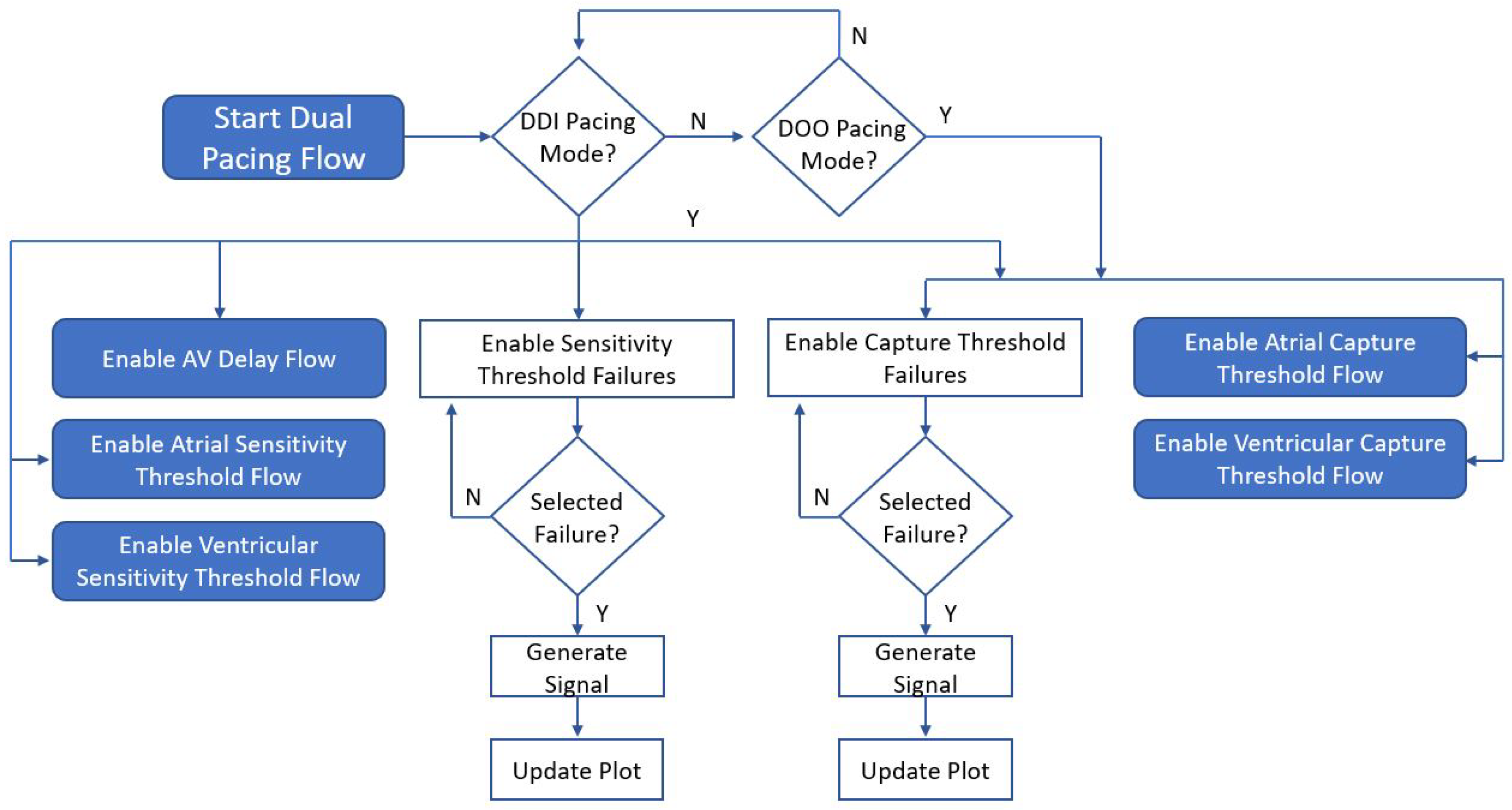
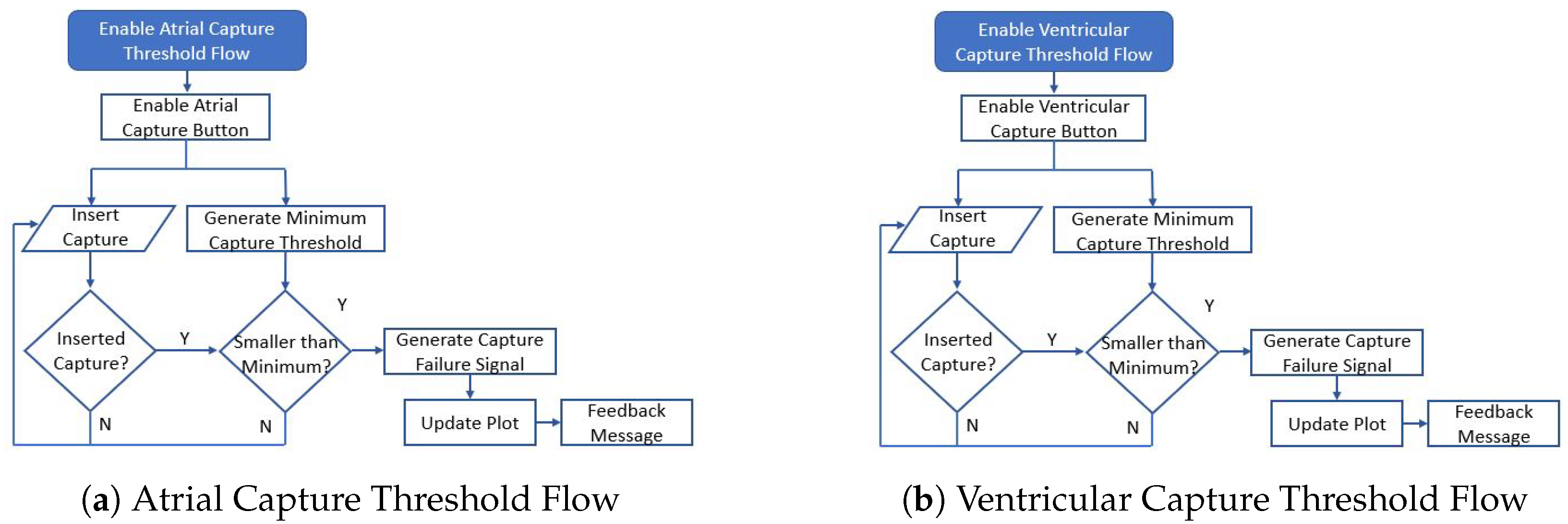



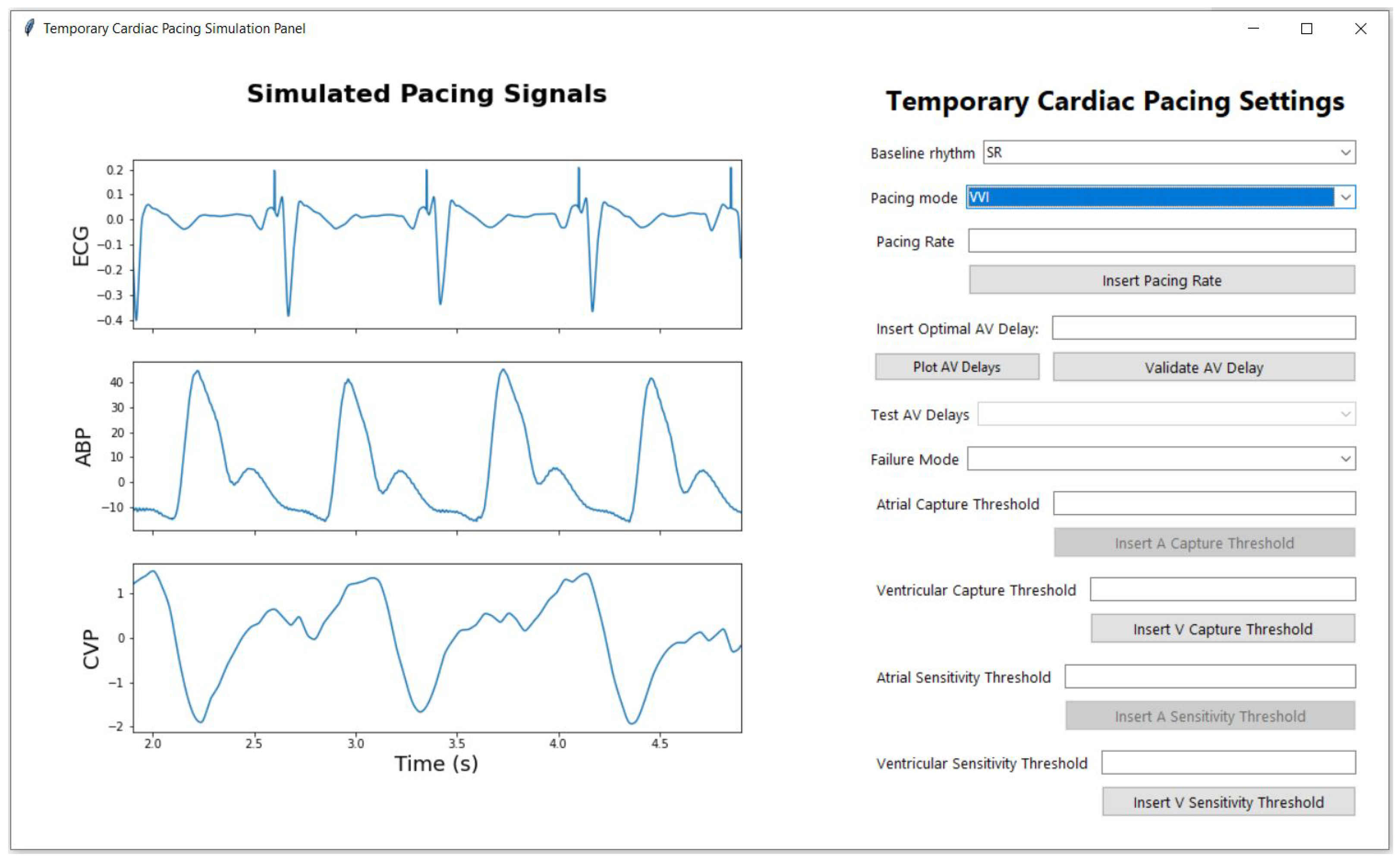
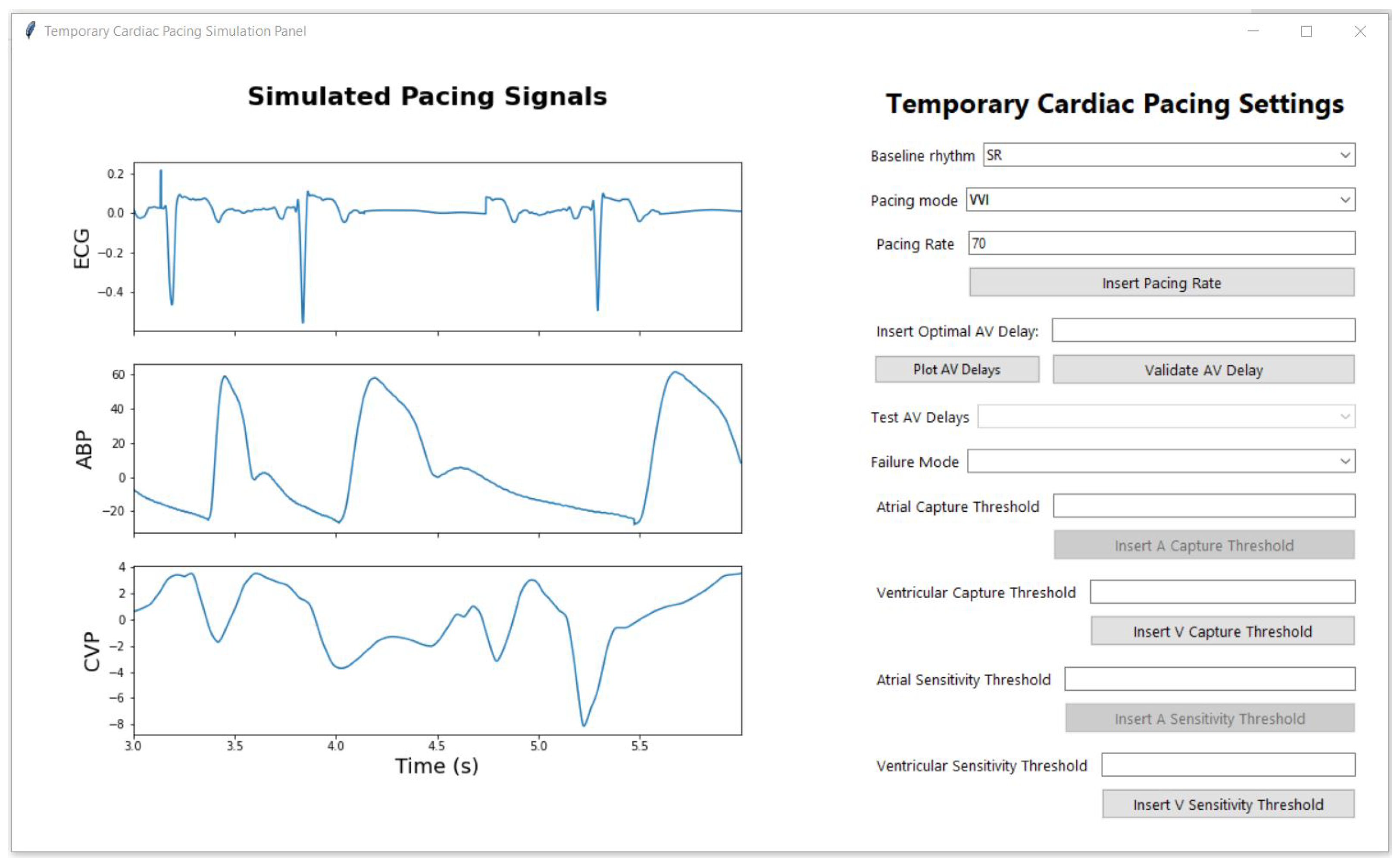
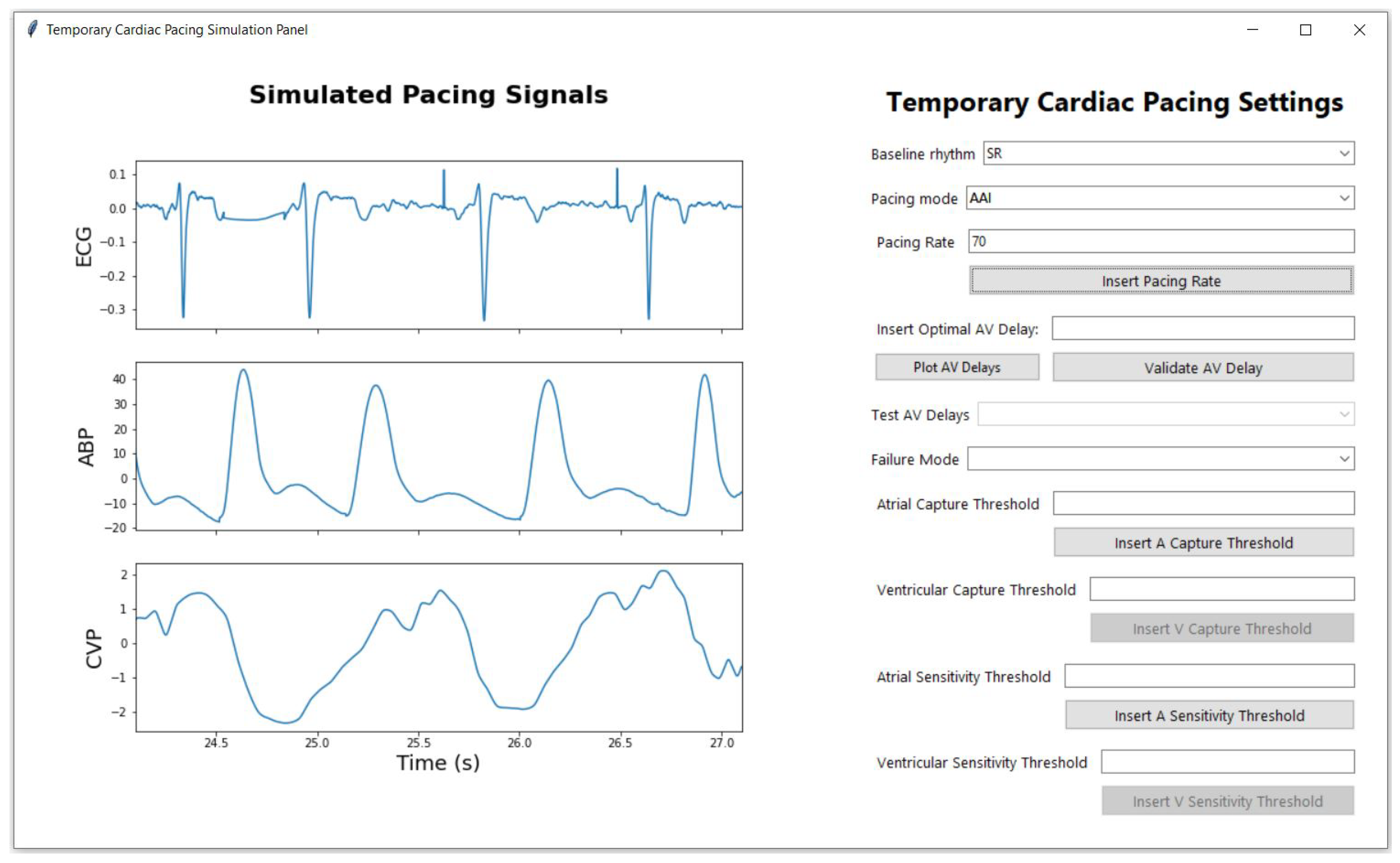
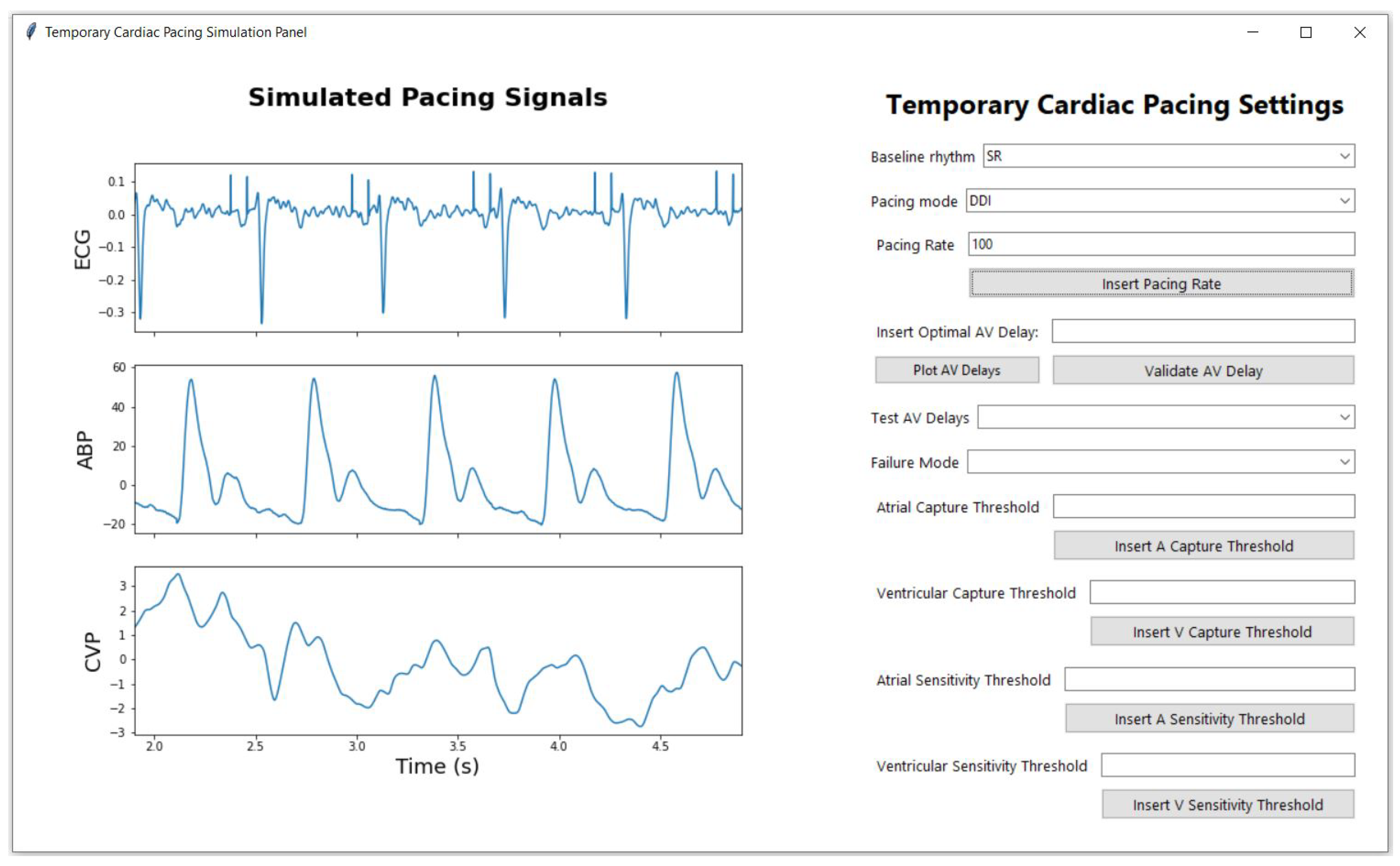
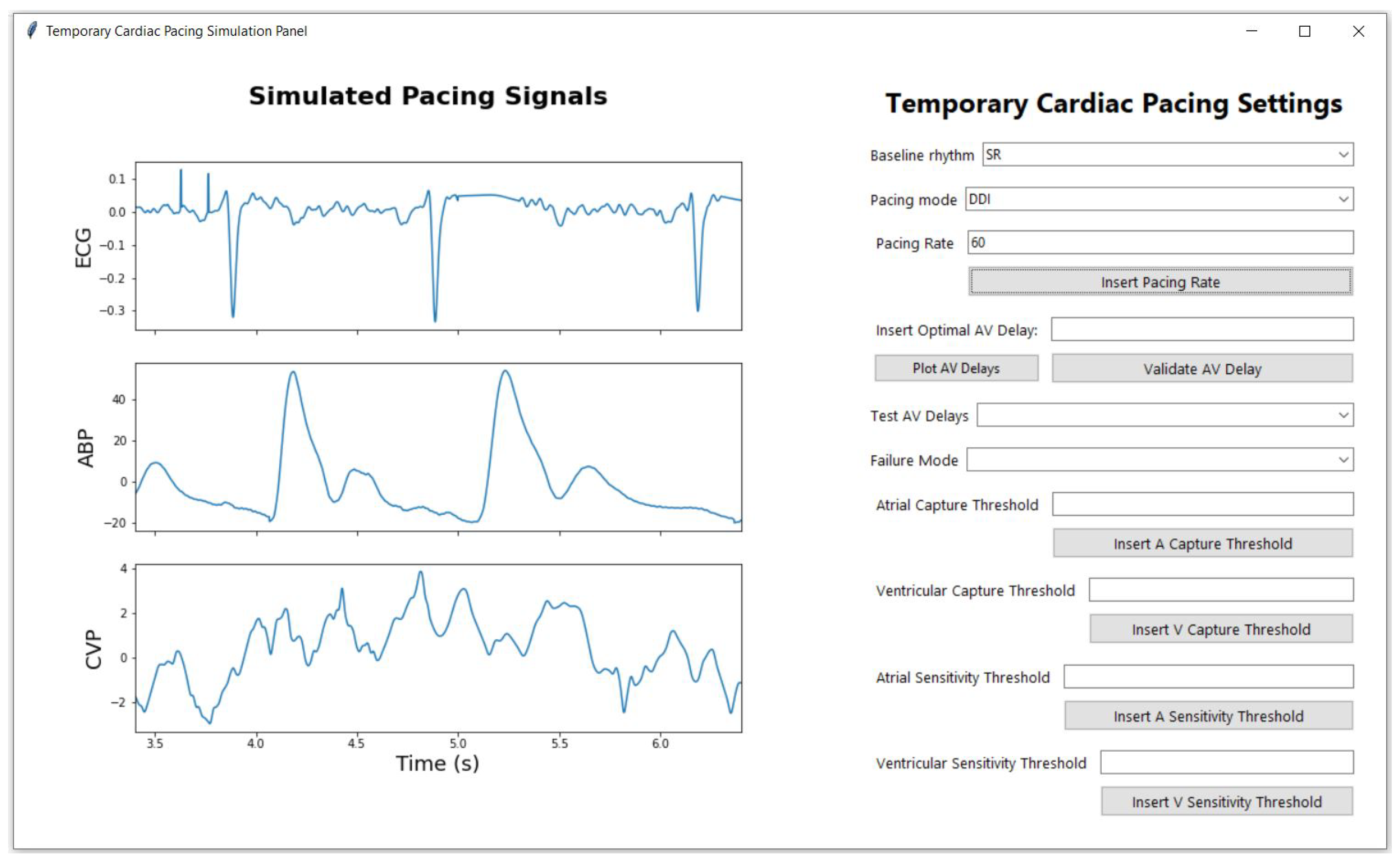
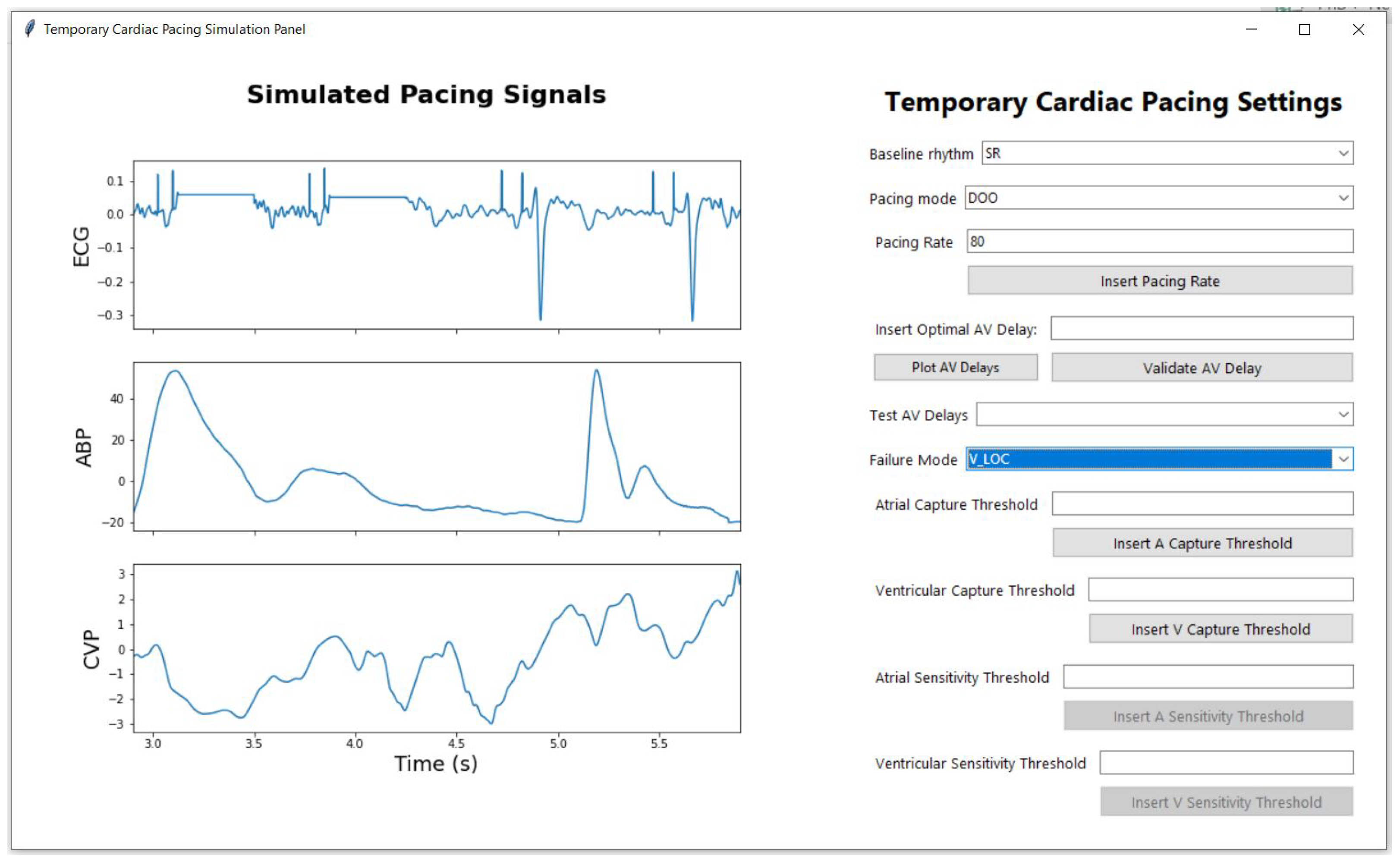

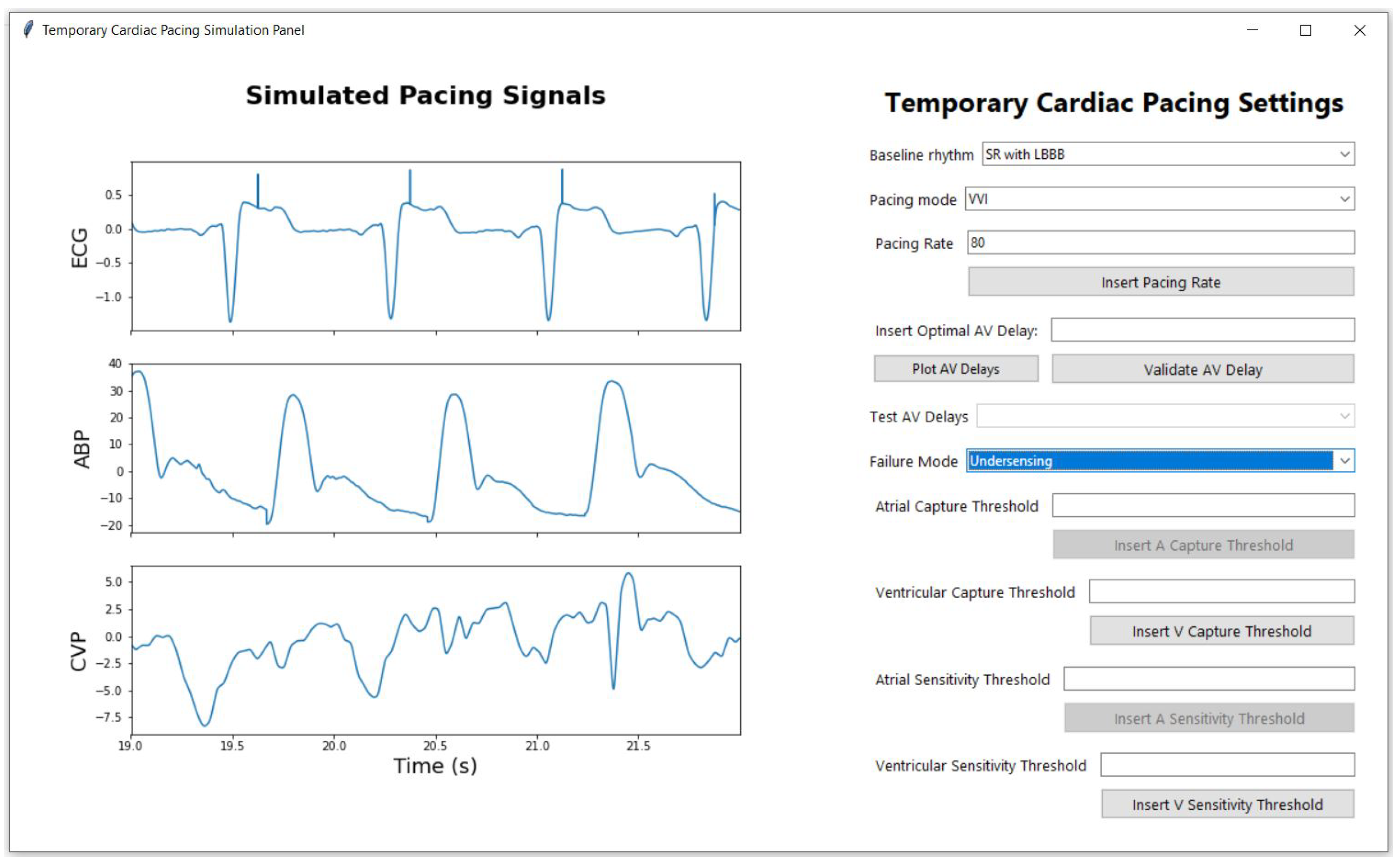
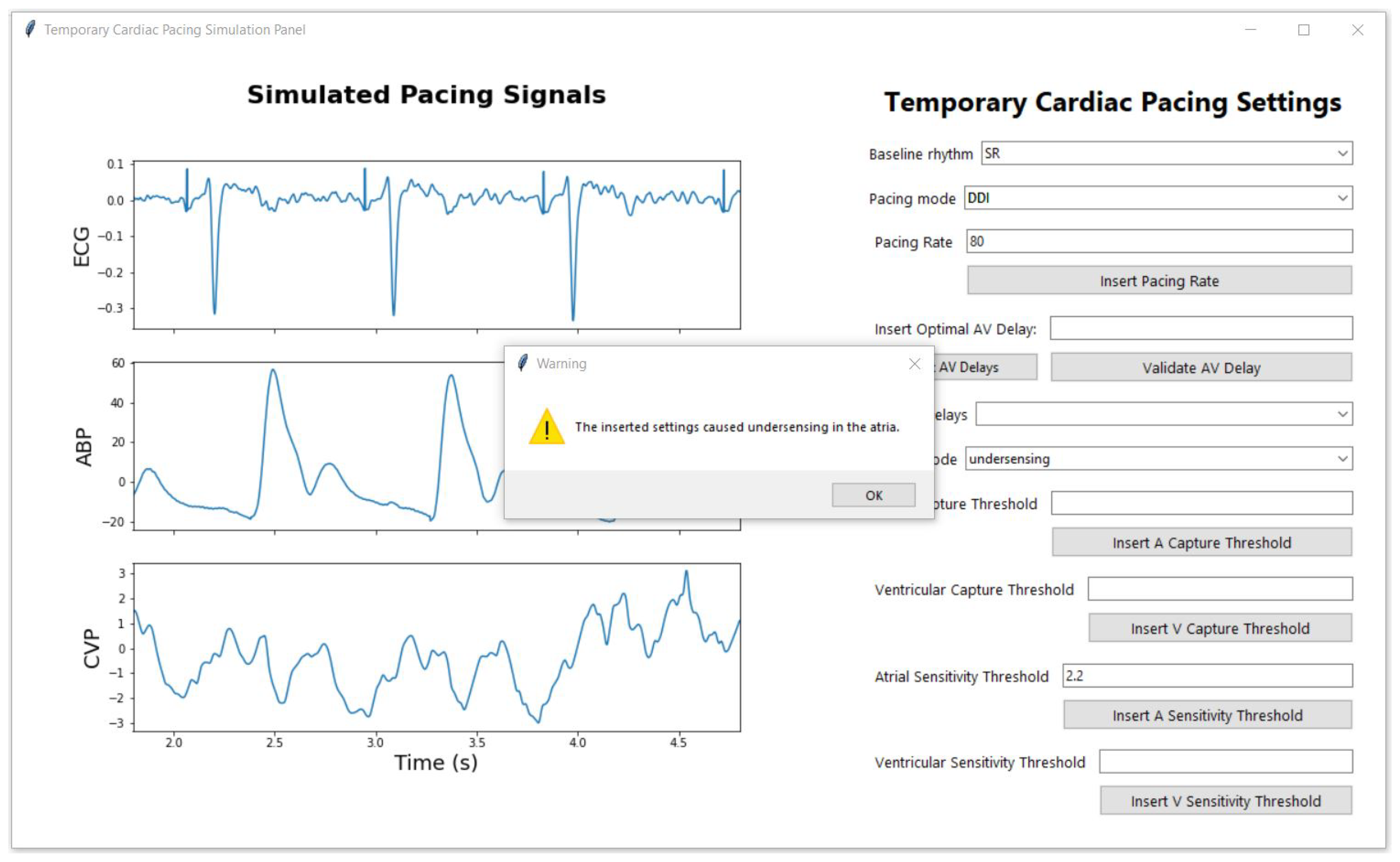

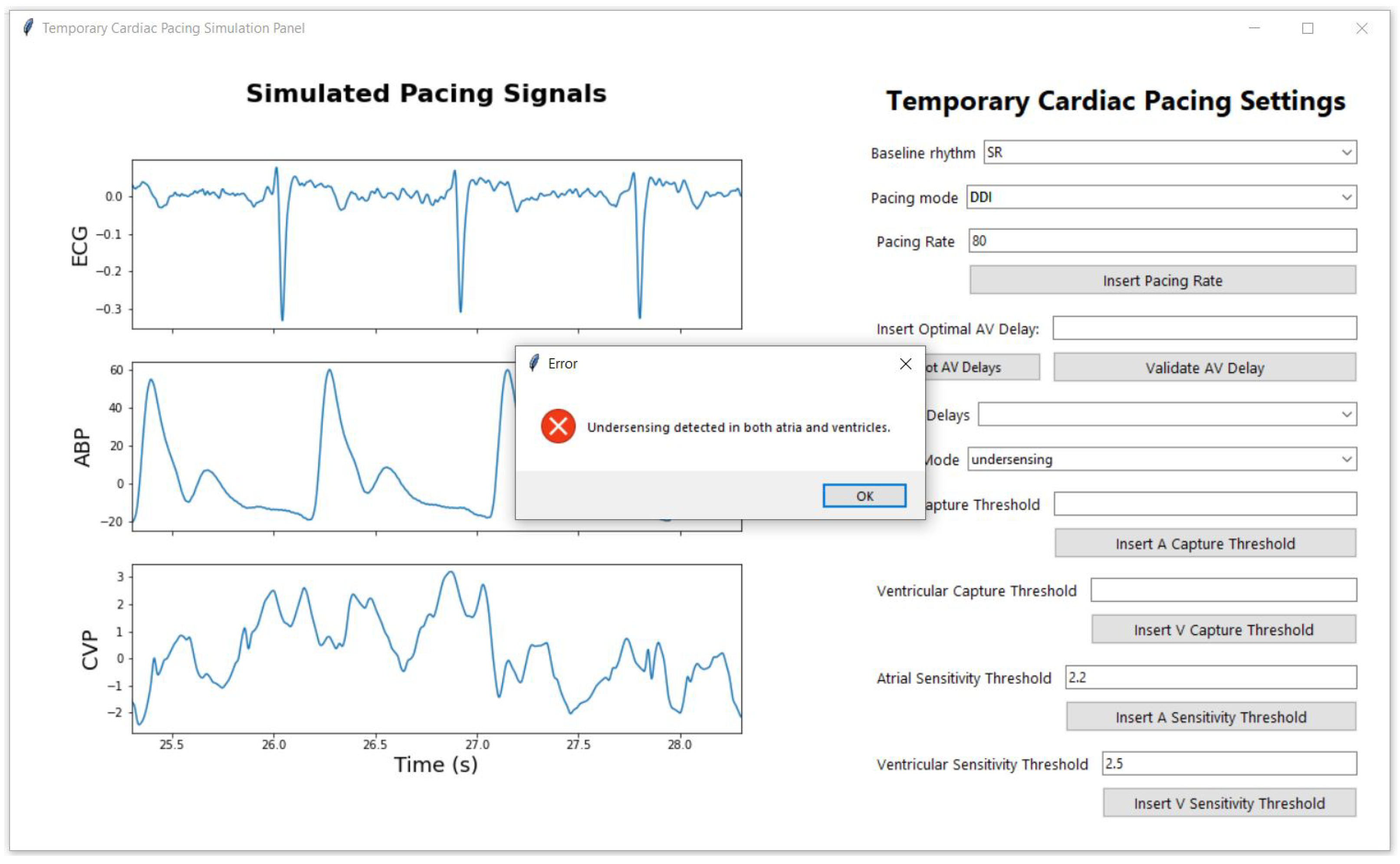
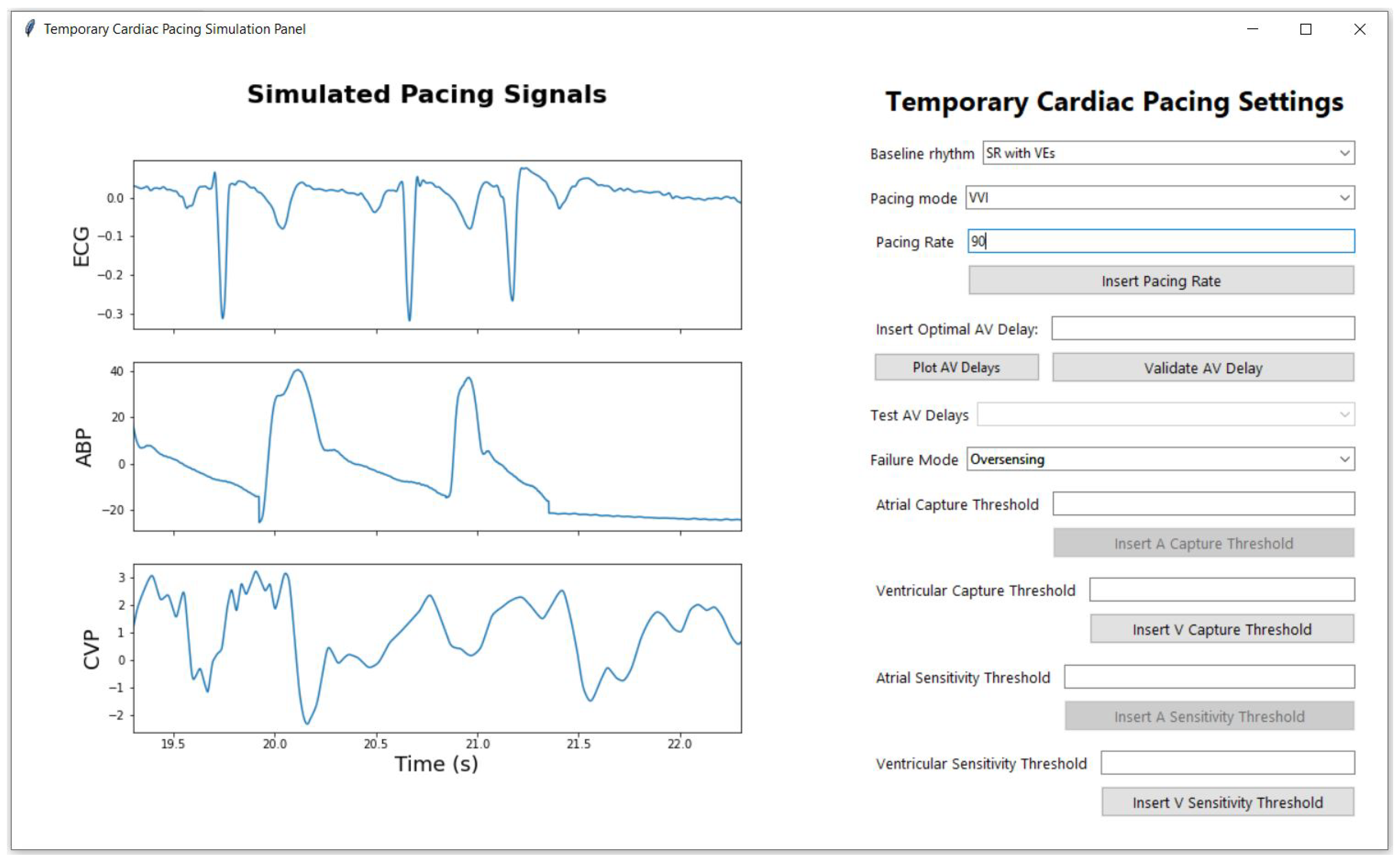
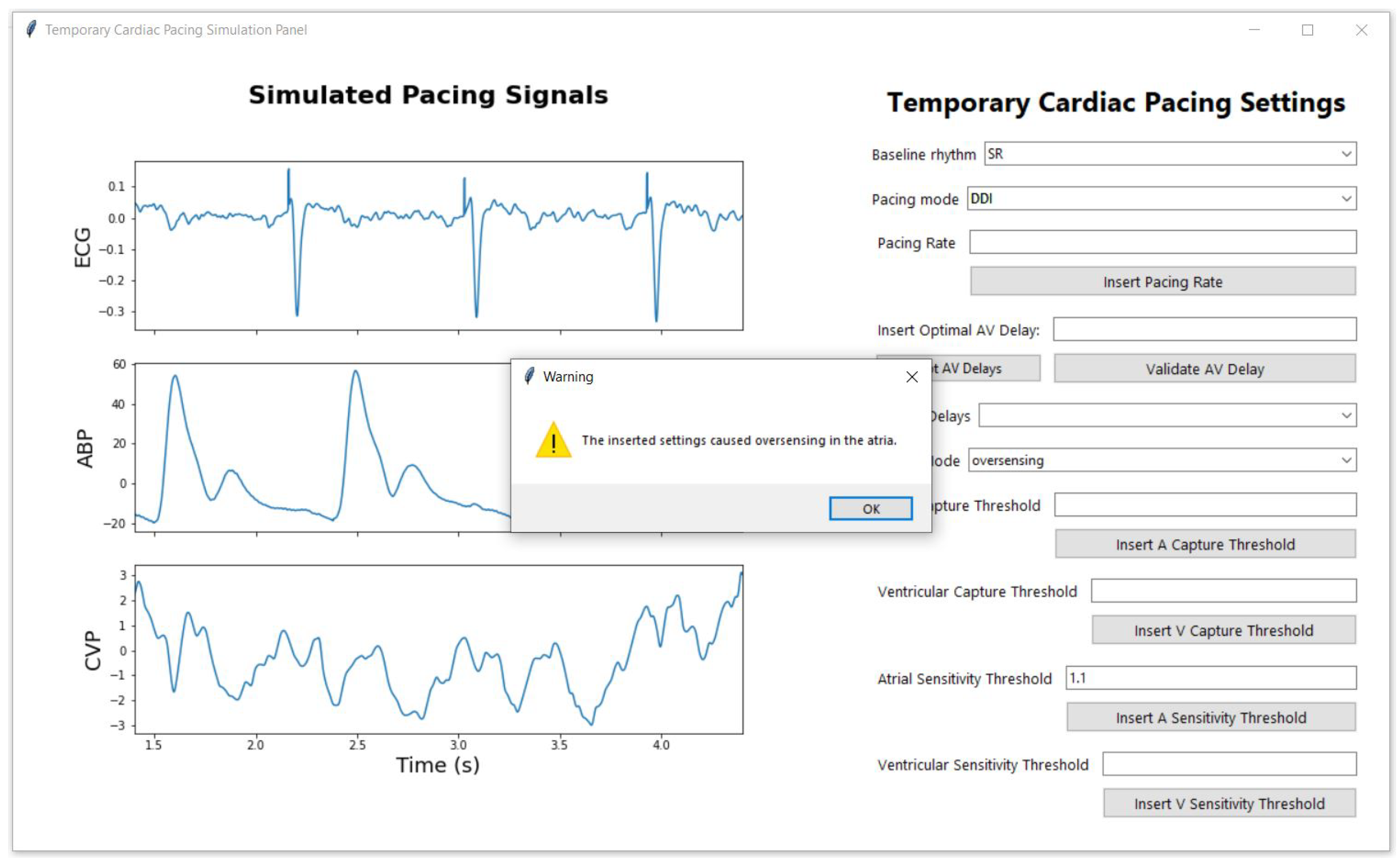
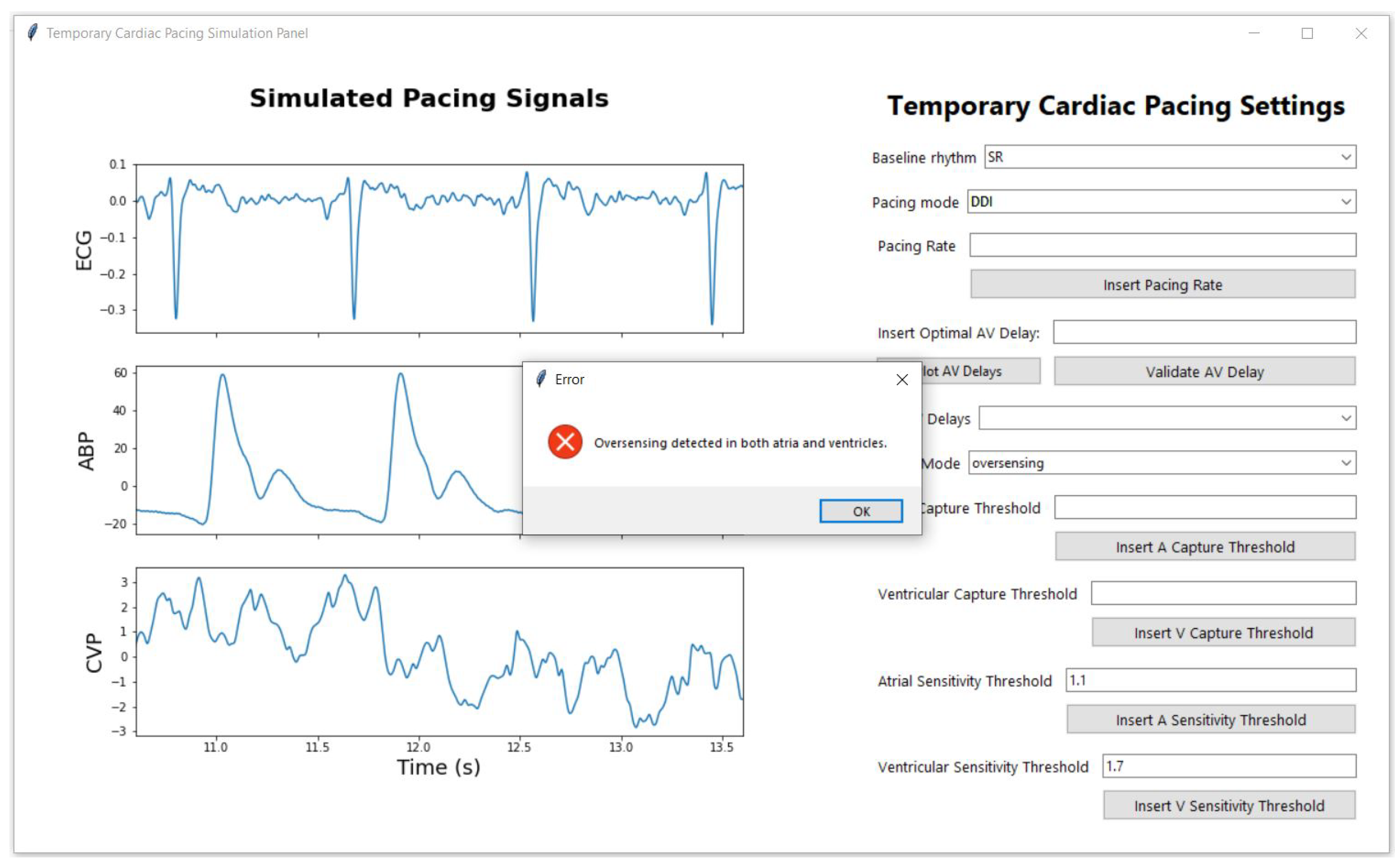

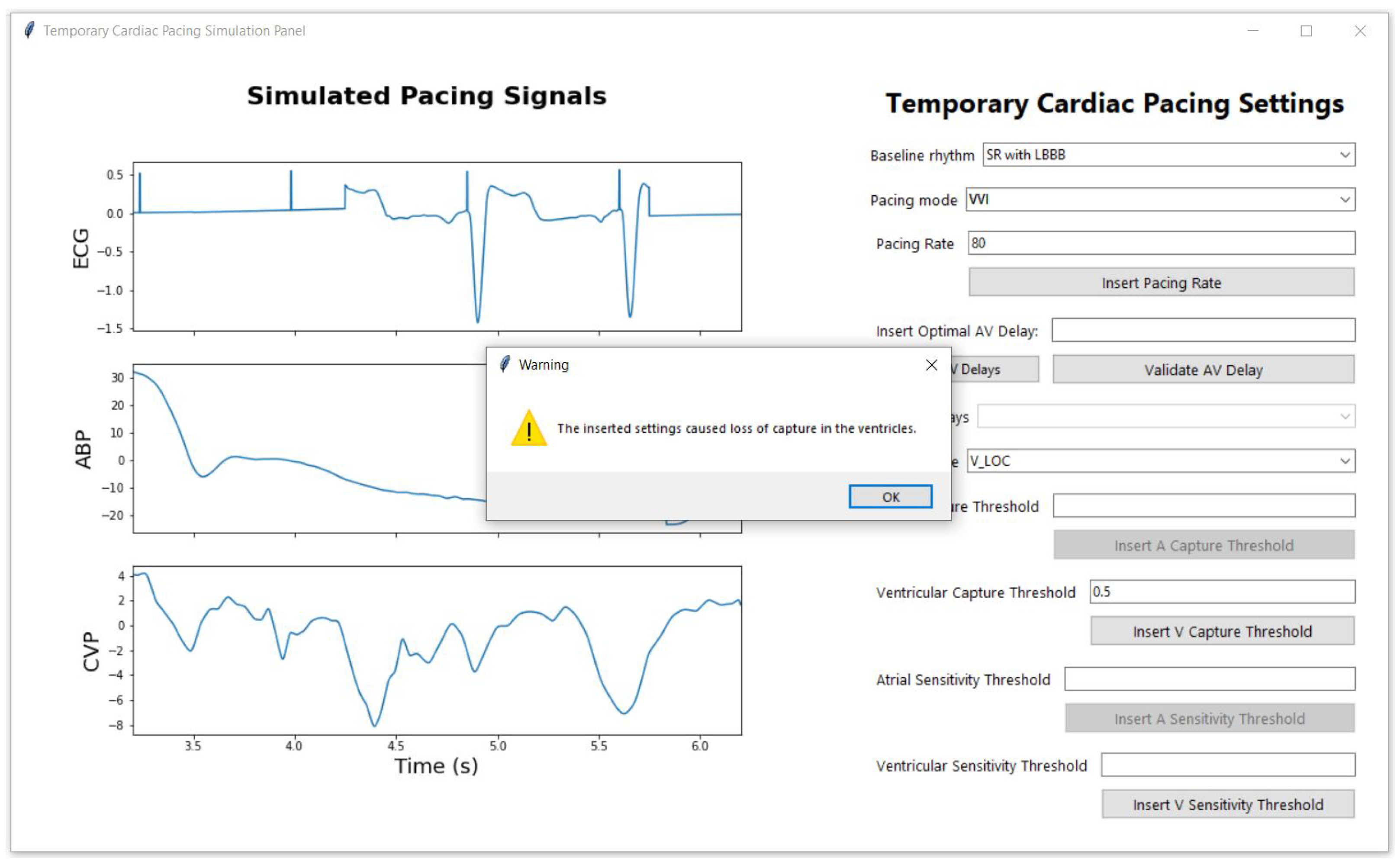

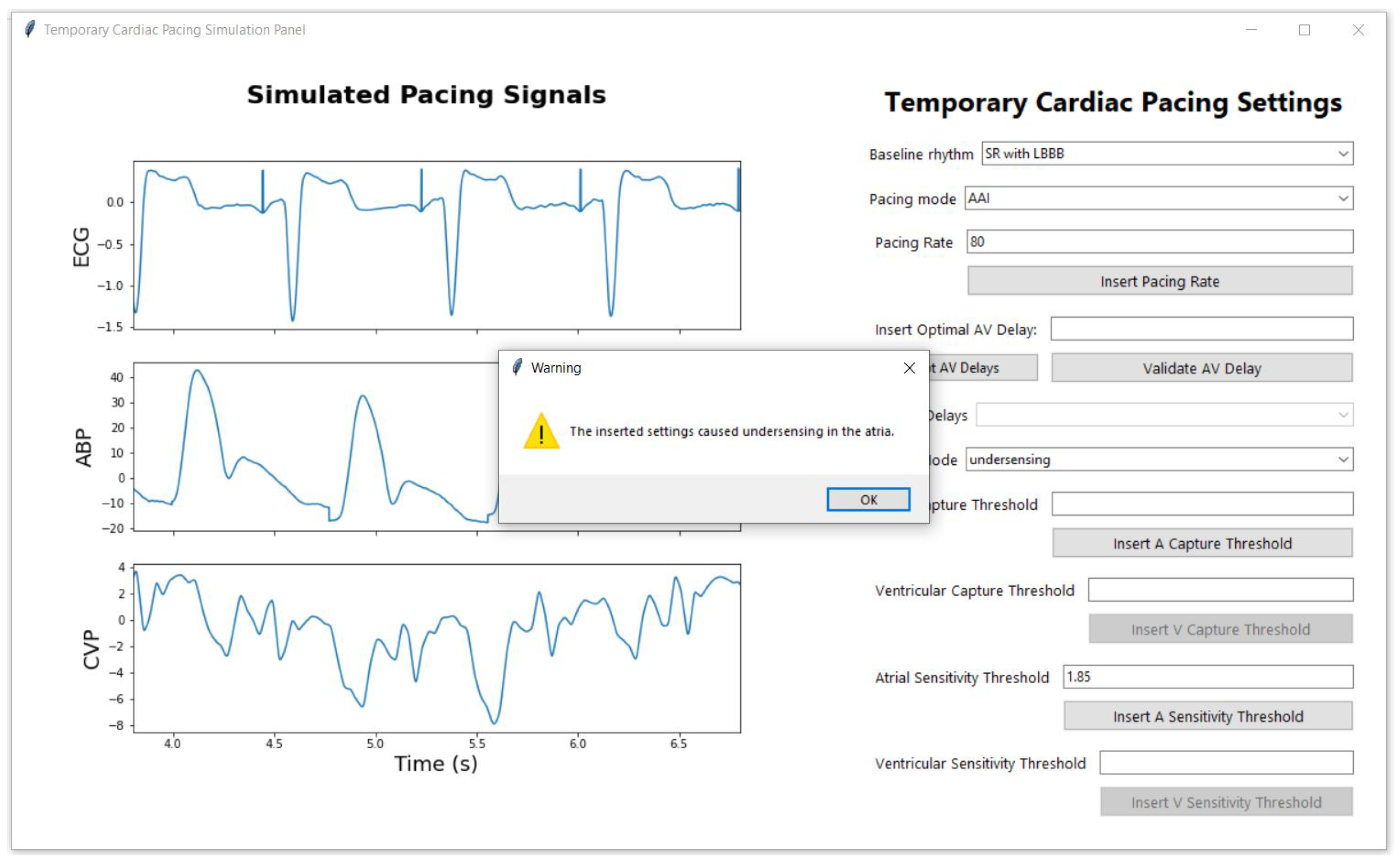

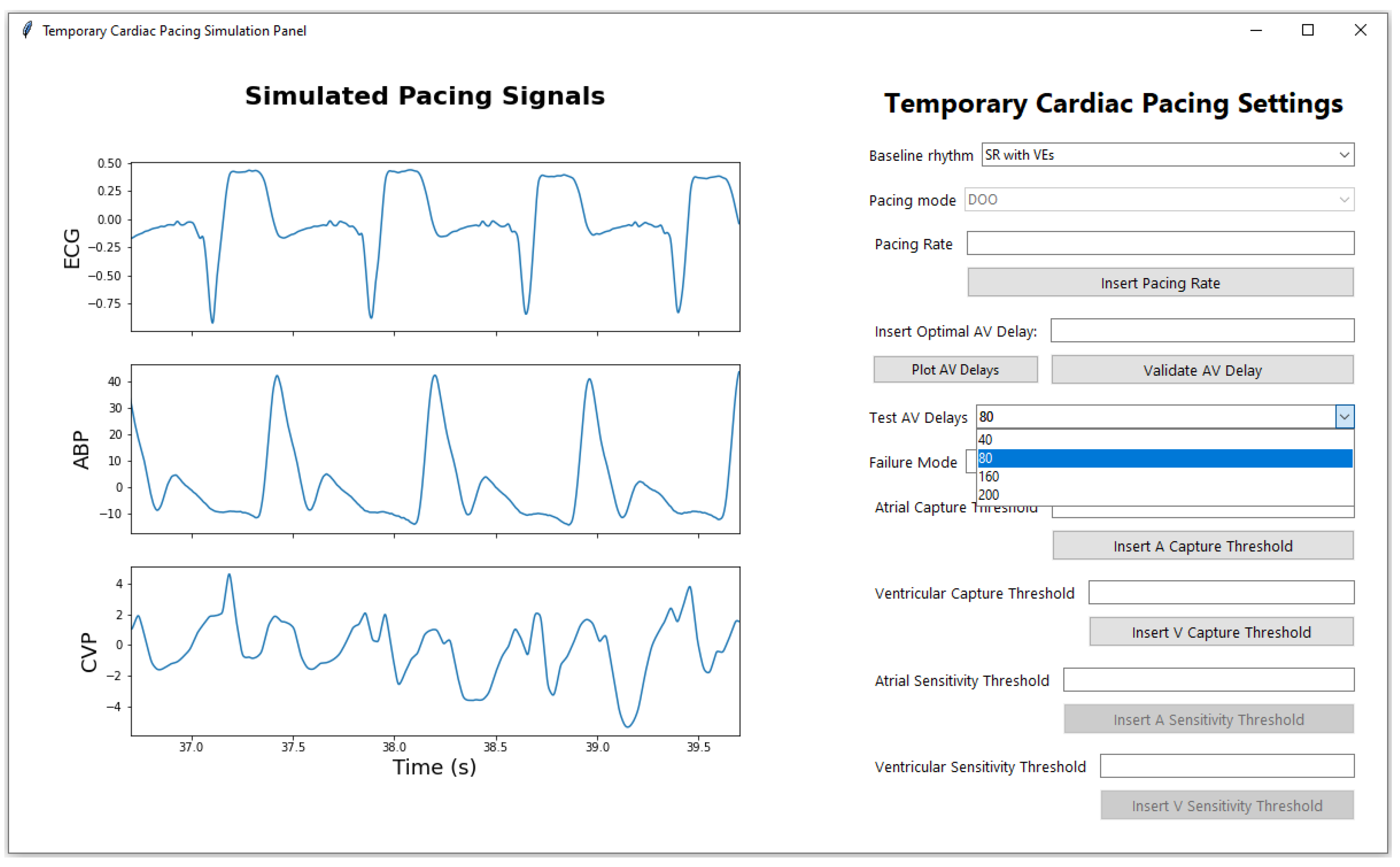
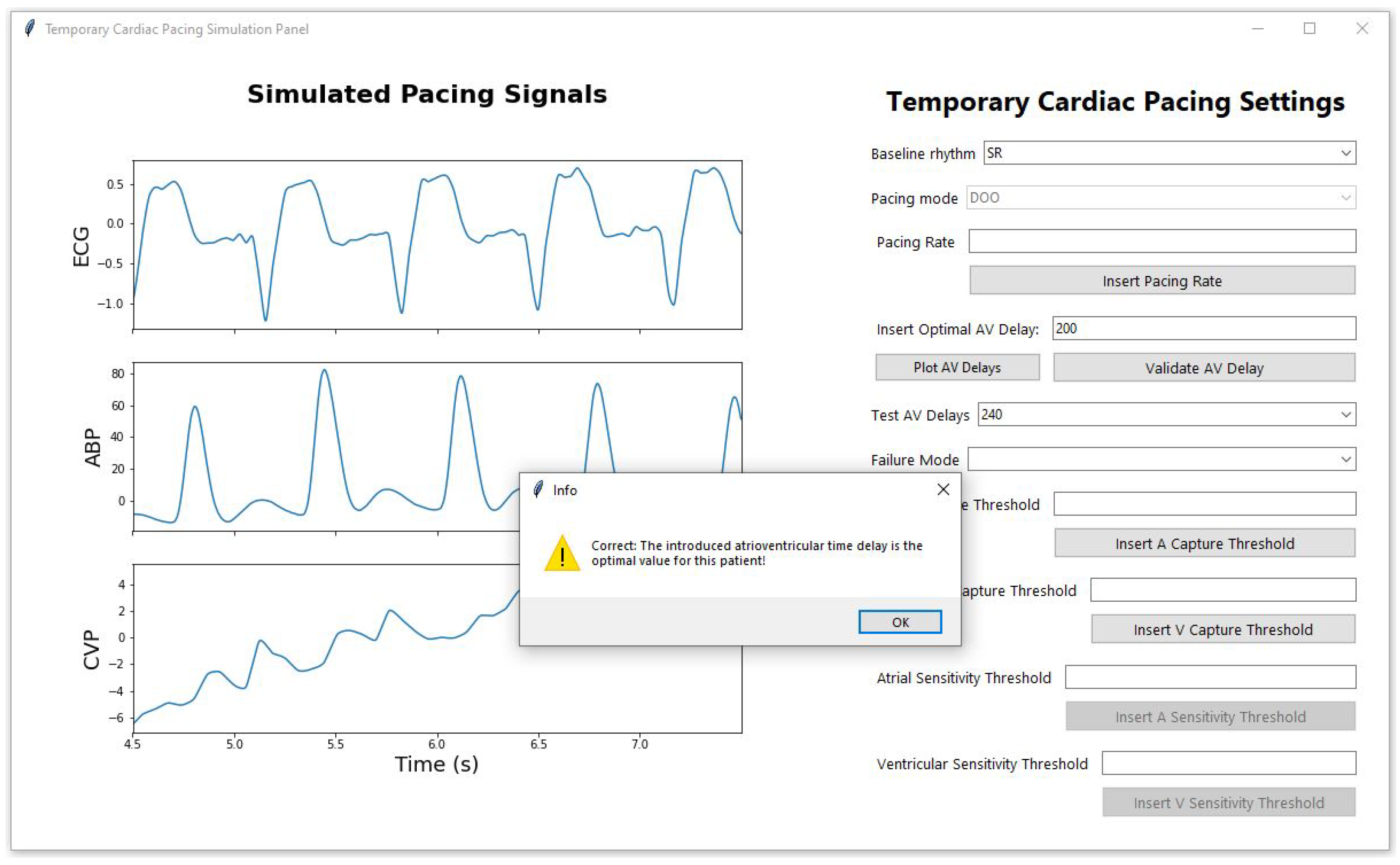

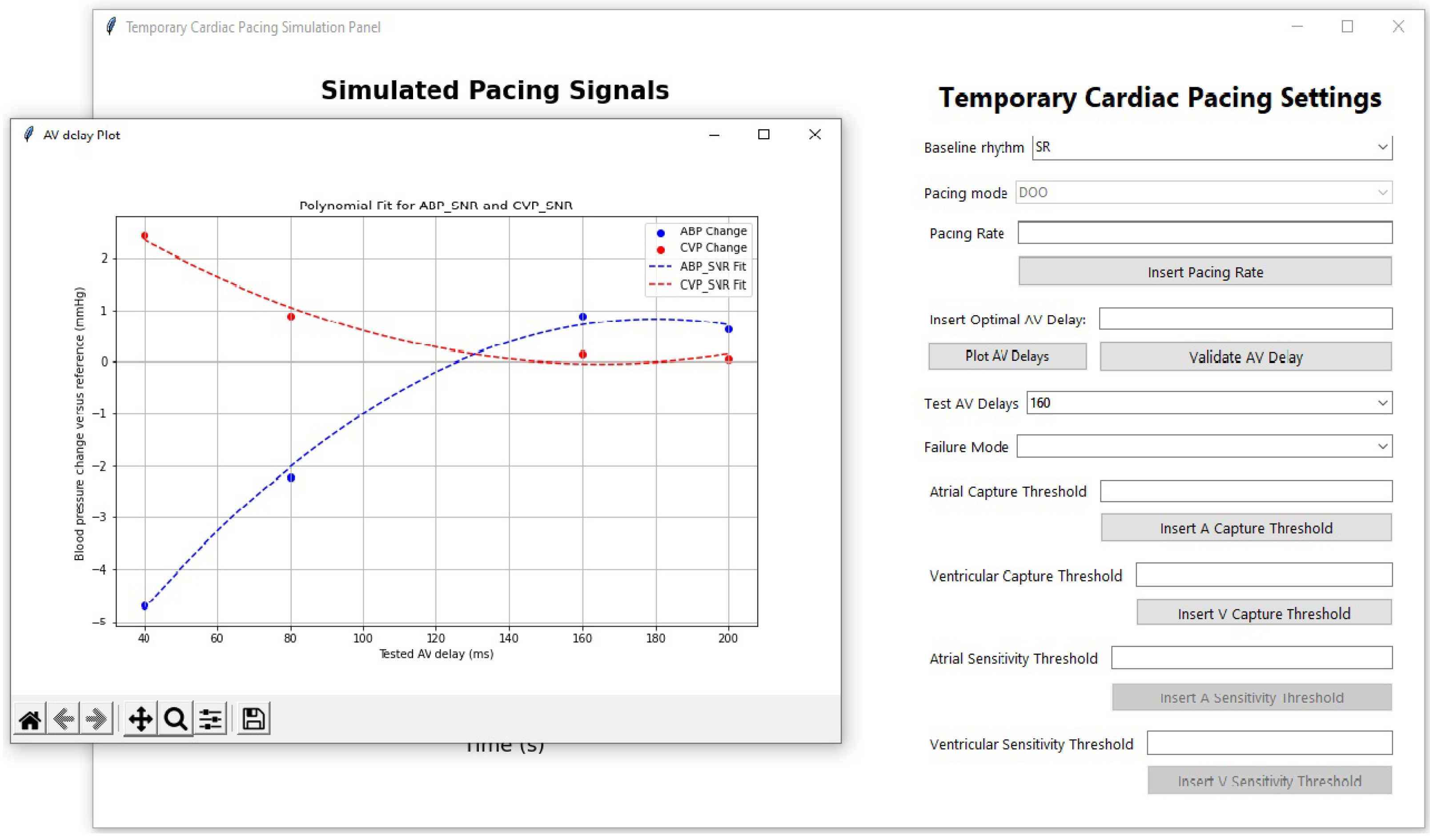
Disclaimer/Publisher’s Note: The statements, opinions and data contained in all publications are solely those of the individual author(s) and contributor(s) and not of MDPI and/or the editor(s). MDPI and/or the editor(s) disclaim responsibility for any injury to people or property resulting from any ideas, methods, instructions or products referred to in the content. |
© 2025 by the authors. Licensee MDPI, Basel, Switzerland. This article is an open access article distributed under the terms and conditions of the Creative Commons Attribution (CC BY) license (https://creativecommons.org/licenses/by/4.0/).
Share and Cite
Cretu, I.; Tindale, A.; Abbod, M.; Balachandran, W.; Khir, A.W.; Meng, H. Temporary Pacing Simulator: A Training Tool for Clinicians. Appl. Sci. 2025, 15, 573. https://doi.org/10.3390/app15020573
Cretu I, Tindale A, Abbod M, Balachandran W, Khir AW, Meng H. Temporary Pacing Simulator: A Training Tool for Clinicians. Applied Sciences. 2025; 15(2):573. https://doi.org/10.3390/app15020573
Chicago/Turabian StyleCretu, Ioana, Alexander Tindale, Maysam Abbod, Wamadeva Balachandran, Ashraf W. Khir, and Hongying Meng. 2025. "Temporary Pacing Simulator: A Training Tool for Clinicians" Applied Sciences 15, no. 2: 573. https://doi.org/10.3390/app15020573
APA StyleCretu, I., Tindale, A., Abbod, M., Balachandran, W., Khir, A. W., & Meng, H. (2025). Temporary Pacing Simulator: A Training Tool for Clinicians. Applied Sciences, 15(2), 573. https://doi.org/10.3390/app15020573








